Patagonia is a vast and rugged region at the southern tip of South America, which encompasses parts of Argentina and Chile. It is known for its diverse landscapes, from snow-capped mountains to sprawling grasslands, and is home to an array of unique flora and fauna.
Among the many species that inhabit this region, birds are one of the most fascinating and diverse. Patagonia’s avian fauna includes a variety of migrants, residents, and endemics, making it a paradise for bird enthusiasts and nature lovers alike.
This article introduction will delve into the incredible diversity of birds found in Patagonia, their significance, and the various habitats they occupy.
1. Crested Caracara
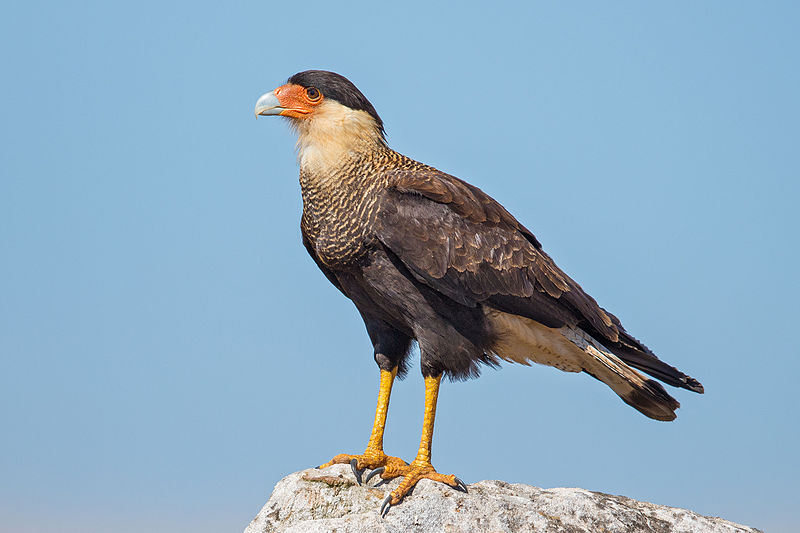
The Crested Caracara is a majestic bird of prey found from the Southern United States through Central and South America, all the way down to Tierra del Fuego.
It has an impressive wingspan ranging from 120-132 cm, with adults averaging 1,348 g in weight. This species is known for its characteristic crest on top of their head that can be raised when they are alarmed or excited.
They have pale yellow legs and feet along with dark brown feathers covering most of their body.
The Crested Caracara feeds mainly on carrion but will also take live food such as small mammals, reptiles and birds as well as garbage if it’s available near them.
These amazing raptors form strong family bonds between siblings which often last until adulthood; making them one of nature’s most remarkable creatures.Scientific classification:
| Kingdom | Animalia |
| Phylum | Chordata |
| Class | Aves |
| Order | Falconiformes |
| Family | Falconidae |
| Genus | Caracara |
| Species | C. plancus |
Also Featured In: Most Popular Bird Species in North America, Scavengers Birds You Should Know
2. Southern Lapwing
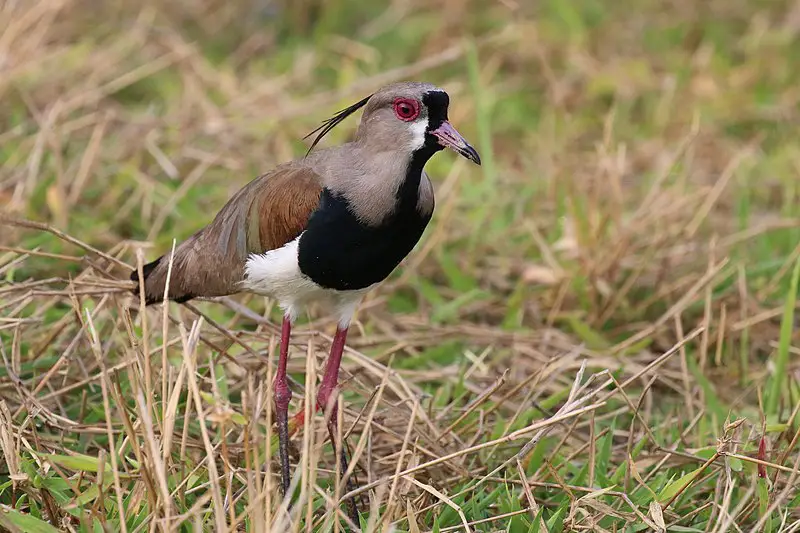
The Southern lapwing, also known as quero-quero in Brazil or tero in Argentina and Uruguay, is a wader that can be found throughout South America.
It inhabits open areas like grasslands and fields but avoids heavily forested regions such as the Amazon basin.
This bird has an unmistakable appearance with its black-and-white plumage contrasting against its bright yellow bill and legs.
The male’s feathers are more vibrant than those of the female, making them easily distinguishable from each other.
They feed on worms and insects which they search for by probing their long bills into soft ground while walking around looking for food.
Lapwings are highly territorial birds who will protect their nests fiercely from any potential predators or intruders.Scientific classification:
| Kingdom | Animalia |
| Phylum | Chordata |
| Class | Aves |
| Order | Charadriiformes |
| Family | Charadriidae |
| Genus | Vanellus |
| Species | V. chilensis |
Also Featured In: Beautiful Brazilian Birds, Most Common Birds in South America Birds
3. Rheas
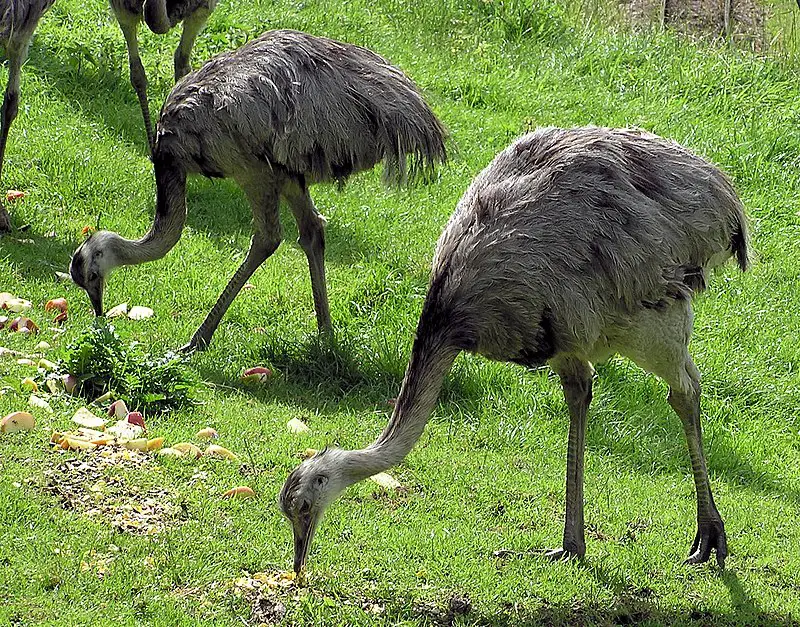
Rheas are large flightless birds native to South America, related to the ostrich and emu. There are two extant species: The Greater or American Rhea (Rhea americana) and the lesser or Darwin’s Rhea (Pterocnemia pennata).
They have long legs, strong feet with three toes that help them run swiftly on land; they can also swim well.
Their wings may be small but they’re used for balance during running. These birds usually weigh between 30-60 pounds depending on the species, with a length of up to 6 ft.
Both male and female rheas display plumage in shades of greyish browns which blend into their surroundings – perfect camouflage.Scientific classification:
| Kingdom | Animalia |
| Phylum | Chordata |
| Class | Aves |
| Infraclass | Palaeognathae |
| Order | Rheiformes |
| Family | Rheidae |
| Genus | Rhea Brisson, 1760 |
4. Kelp Gull
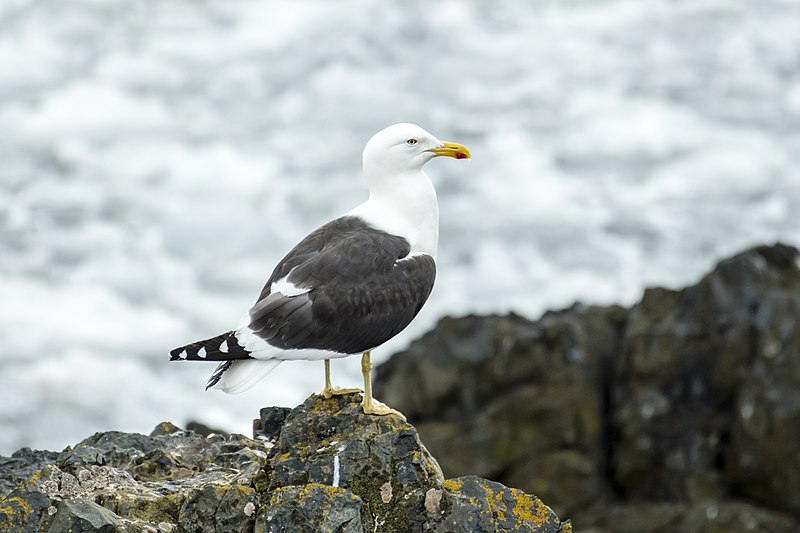
The Kelp Gull is a majestic bird that can be found on coasts and islands of the Southern Hemisphere. It has a beautiful plumage consisting of black, white and grey feathers with brown eyes.
Its wingspan ranges between 91-122 cm (36 – 48 inches). The nominate L. d. dominicanus subspecies is most commonly seen around South America, parts of Australia, and New Zealand where it goes by the name “black-backed gull” or “mollyhawk”.
These birds are omnivorous but tend to prefer fish as their primary food source while they also scavenge carrion when necessary.
In order to stand out from other seagulls during mating season they display vibrant courtship rituals which involve flying high in circles over its nesting area flapping their wings dramatically before diving down into the water near potential mates.Scientific classification:
| Kingdom | Animalia |
| Phylum | Chordata |
| Class | Aves |
| Order | Charadriiformes |
| Family | Laridae |
| Genus | Larus |
| Species | L. dominicanus |
Also Featured In: Birds of South African, Common Birds of Weddell Island
5. Andean Condor
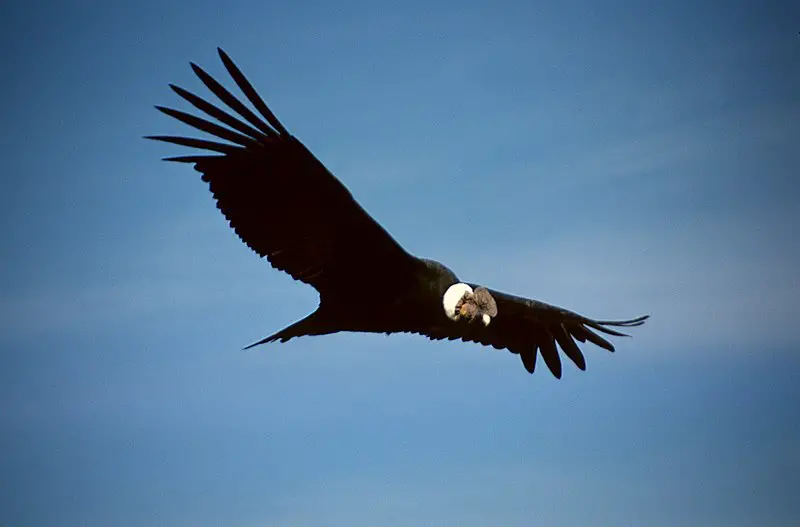
The Andean condor is a giant South American Cathartid vulture and the only member of its genus.
Found in the Andes mountains and along Pacific coasts, it is thought to be the largest flying bird on Earth by weight and wingspan with a maximum wingspan reaching up to 10 feet 10 inches (3.3 m) and weighing 33 lbs (15 kg).
It has mainly black plumage which helps keep it warm at high altitudes, while white patches adorn its head, neck, chest as well as underwing coverts.
Its powerful bill allows it to consume carrion efficiently while also being able to crack bones for nutrition when necessary.
The amazing flight capabilities of this majestic creature allow them soar through air thermals effortlessly; making them an impressive sight against clear blue skies.Scientific classification:
| Kingdom | Animalia |
| Phylum | Chordata |
| Class | Aves |
| Order | Accipitriformes |
| Family | Cathartidae |
| Genus | Vultur Linnaeus, 1758 |
| Species | V. gryphus |
Also Featured In: Common Birds in Colombia, Aviary Birds You Should Know
6. Hooded Grebe
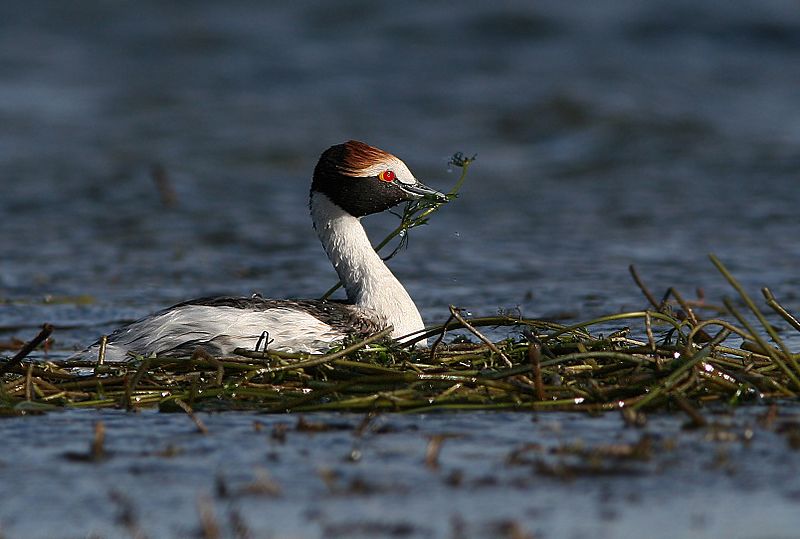
The Hooded Grebe is a small bird native to the southern region of Argentina. It grows up to 13 inches in length and has striking black-and-white plumage.
This species inhabits isolated lakes in Patagonia, spending its winters along the coastlines of this remote area.
In 2012, it was uplisted from Endangered to Critically Endangered on IUCN’s Red List due to its declining population numbers caused by human activities such as hunting and pollution.
The Hooded Grebe can be identified by its white chin patch and yellow eyes surrounded by red rings – making for an impressive sight when seen flying across their home waters.
Conservation efforts are essential for safeguarding this unique species so that future generations may enjoy admiring them in their natural habitats.Scientific classification:
| Kingdom | Animalia |
| Phylum | Chordata |
| Class | Aves |
| Order | Podicipediformes |
| Family | Podicipedidae |
| Genus | Podiceps |
| Species | P. gallardoi |
Also Featured In: Birds of Argentina,
7. Black-Necked Swan
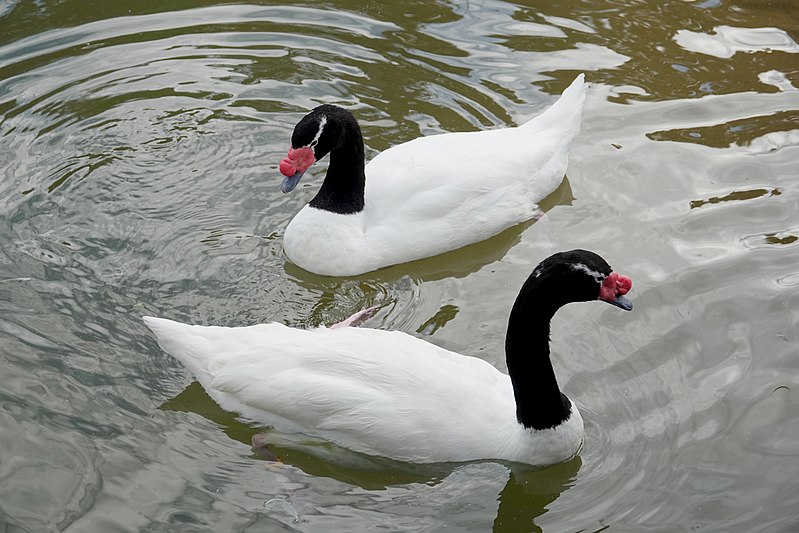
The Black-necked Swan is a species of waterfowl belonging to the Cygnini tribe in subfamily Anserinae. They are native to Argentina, Brazil, Chile, Uruguay and the Falkland Islands.
The black-necked swan has been known to stand out from other members of its family due to its unique appearance; it has an all white body with a black neck and head.
This bird typically lives near freshwater bodies such as lakes or rivers but can also be found on ocean coasts during some seasons when food sources become scarce.
It mainly feeds on algae and aquatic plants though occasionally eats small fish too for extra nutrition.
Overall this gorgeous bird stands proud amongst many others because of their stunning colour combination which makes them unmistakable.Scientific classification:
| Kingdom | Animalia |
| Phylum | Chordata |
| Class | Aves |
| Order | Anseriformes |
| Family | Anatidae |
| Genus | Cygnus |
| Species | C. melancoryphus |
8. Austral Rail
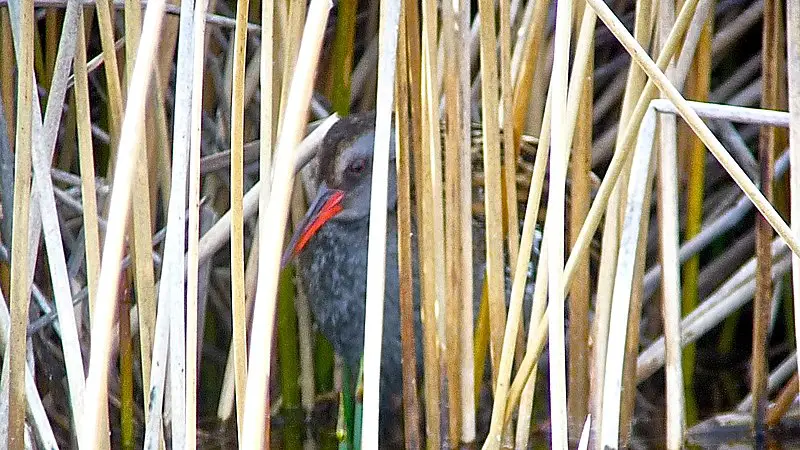
The Austral Rail is a vulnerable species of bird found primarily in Argentina and Chile. It belongs to the Rallinae subfamily of the family Rallidae, which includes rails, gallinules and coots.
While some have suggested that it be classified as conspecific with Virginia Rails (R. limicola), this has not been widely accepted by experts.
The austral rail is monotypic; there are no other known species within its genus or family that share similar physical characteristics or behaviors.
Its diet consists mostly of small insects such as grasshoppers, crickets, caddisflies and mayflies supplemented occasionally with vegetation like seeds and leaves during winter months when insect sources become scarce.
Conservation efforts must continue if we wish to keep this unique creature safe from extinction.Scientific classification:
| Kingdom | Animalia |
| Phylum | Chordata |
| Class | Aves |
| Order | Gruiformes |
| Family | Rallidae |
| Genus | Rallus |
| Species | R. antarcticus |
9. Chiloé Wigeon
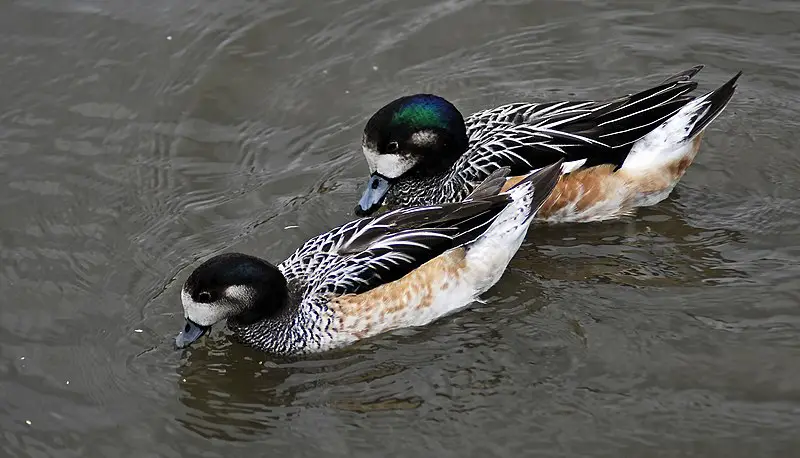
The Chiloé Wigeon is a species of dabbling duck native to the southern parts of South America, including the eponymous Chiloé Archipelago. It has an unmistakable plumage – brown and white with light gray patches on its head and neck.
The wigeon can be found in freshwater lakes, marshes, swamps and lagoons throughout its range. They mostly feed on aquatic vegetation but have also been observed eating insects.
This species is sometimes known as Pato Overo (“piebald duck”) or Pato Real (“royal duck”) due to their striking colouration which stands out among other waterfowls in the region.
Although not globally threatened at present, local populations may be declining owing to hunting pressure and habitat destruction caused by human activities such as agriculture expansion and wetland drainage projectsScientific classification:
| Kingdom | Animalia |
| Phylum | Chordata |
| Class | Aves |
| Order | Anseriformes |
| Family | Anatidae |
| Genus | Mareca |
| Species | M. sibilatrix |
10. Darwin’s Rhea
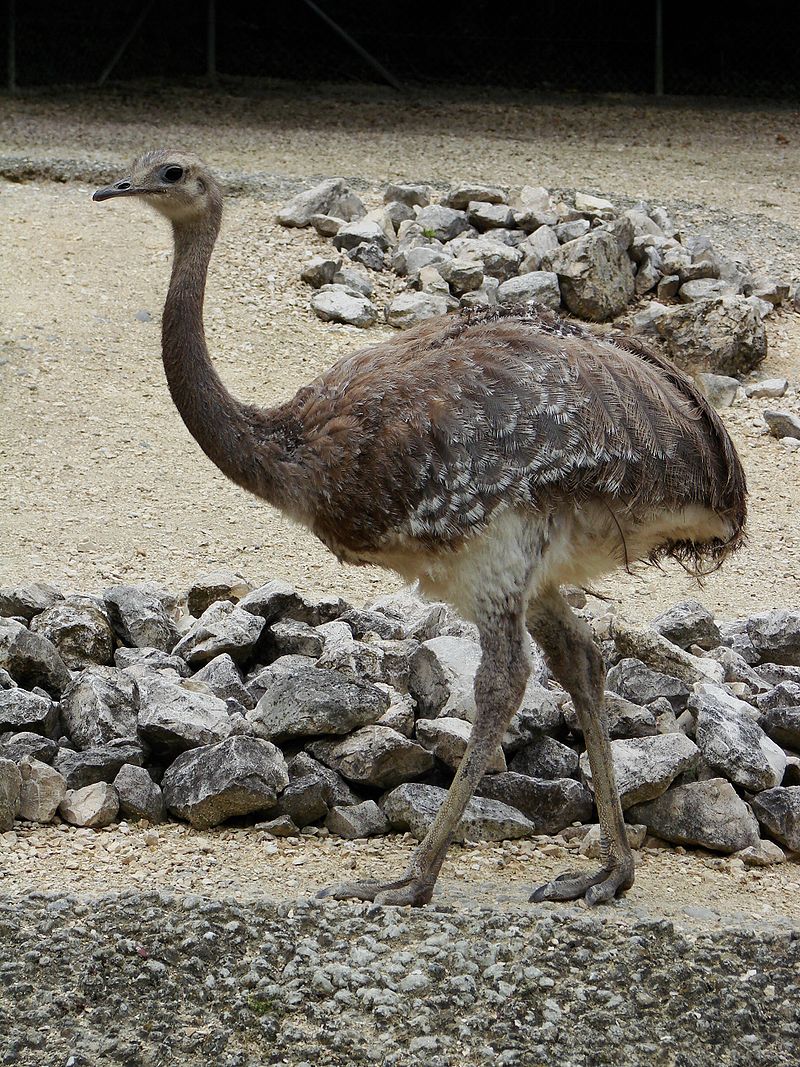
Darwin’s rhea is a flightless bird, the smaller of two extant species of rheas. It stands at 35 to 39 inches tall and has an average length of 36-39 inches with a weight range between 33 – 63 lbs.
The head and bill are both quite small in size compared to other ratites.
This large bird can be found across Altiplano and Patagonia regions in South America where it feeds on plants such as grasses, herbs, roots, bark, fruits etc., while also occasionally consuming insects and lizards.
Most notably they use their powerful legs for running away from predators like foxes or pumas who may attempt to hunt them down due to its slow speed when taking off or flying away isn’t possible.Scientific classification:
| Kingdom | Animalia |
| Phylum | Chordata |
| Class | Aves |
| Infraclass | Palaeognathae |
| Order | Rheiformes |
| Family | Rheidae |
| Genus | Rhea |
| Species | R. pennata |
11. Magellanic Penguin
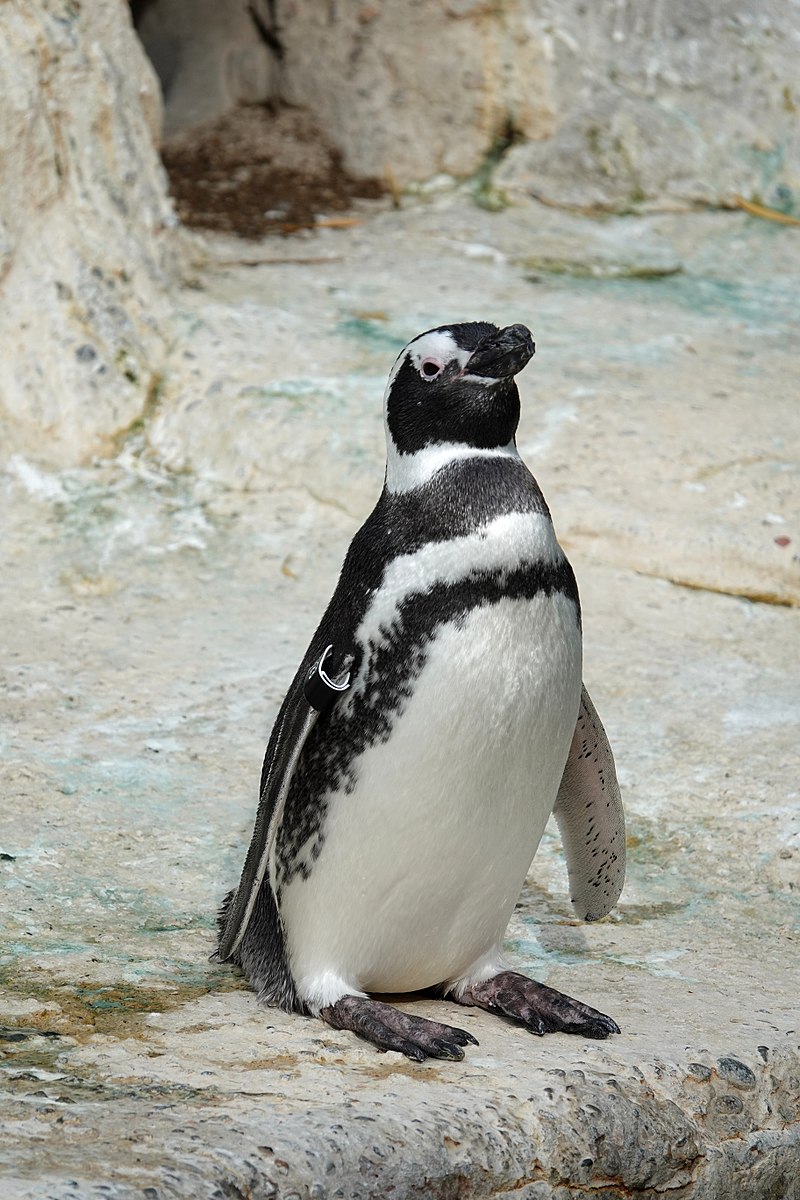
The Magellanic penguin is a beloved South American bird that breeds in coastal Patagonia, including Argentina, Chile and the Falkland Islands. It migrates to Brazil and Uruguay occasionally as far north as Espirito Santo.
Vagrants have even been spotted in El Salvador, Antarctica’s Avian Island and Australia/New Zealand.
This species of penguin is perhaps most recognizable for its striking black-and-white plumage – it has an entirely white underbelly with two distinctive stripes across its back which are black above and white below.
Additionally, they possess large pinkish feet which act like paddles when swimming underwater; these birds can swim up to 20 mph.
The Magellanic Penguin typically lives around 15 years but some may live longer due to their strong social bonds within colonies.
All in all this majestic creature makes quite the statement both on land or sea – making them a unique addition our planet’s wildlife population.Scientific classification:
| Kingdom | Animalia |
| Phylum | Chordata |
| Class | Aves |
| Order | Sphenisciformes |
| Family | Spheniscidae |
| Genus | Spheniscus |
| Species | S. magellanicus |
Also Featured In: Jason Islands Birds You Didn’t Know, Birds That Live around Saunders Island
12. Magellanic Woodpecker
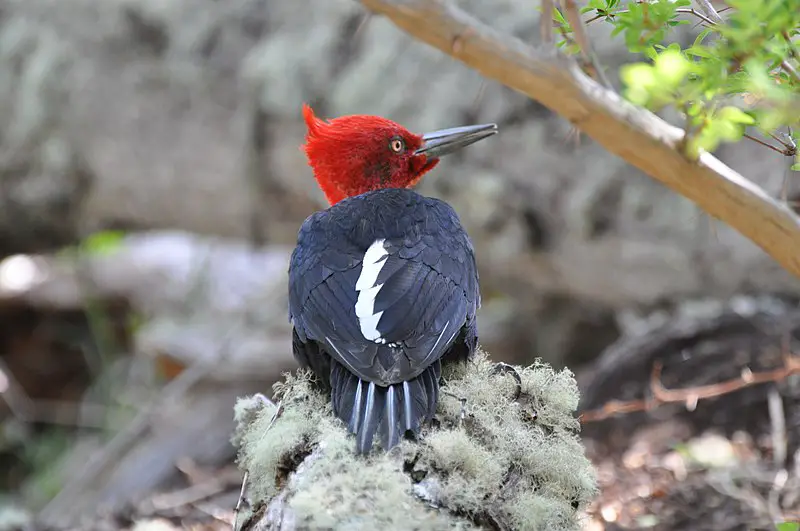
The Magellanic woodpecker is a large species of bird found in the southern regions of Chile and Argentina. It is part of the Campephilus genus, which includes iconic birds such as ivory-billed woodpeckers.
This species can grow to be up to 45 cm (18 inches) long, with males weighing an average of 320 grams (11 ounces). Its plumage consists mostly of black feathers on its head, wings and backside; it has white markings covering its belly area.
The most distinct feature about this bird is its red crest that runs from behind their bill down over their neck and shoulders – hence giving them their name ‘Magellanic’.
These beautiful creatures are known for making loud drumming noises as they search for food like beetles, ants or other insects in tree trunks or branches.
They inhabit dense forests areas where they can find plenty to eat while avoiding being preyed upon by predators.Scientific classification:
| Kingdom | Animalia |
| Phylum | Chordata |
| Class | Aves |
| Order | Piciformes |
| Family | Picidae |
| Genus | Campephilus |
| Species | C. magellanicus |
13. Chilean Flamingo
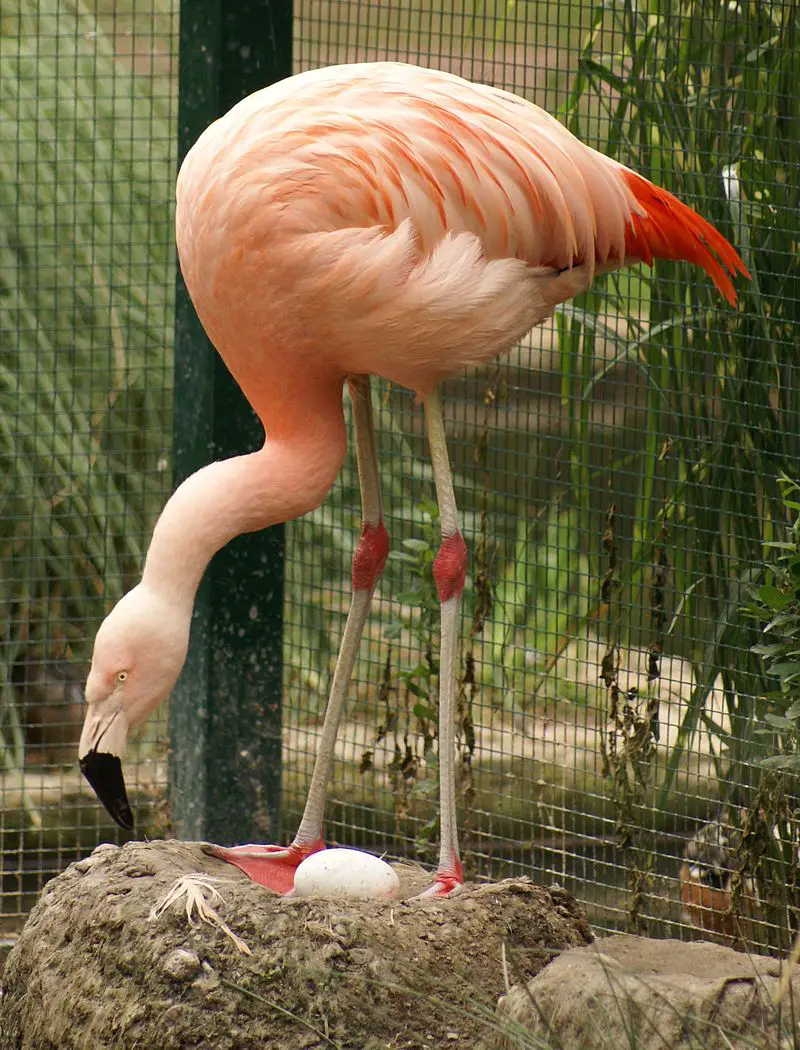
The Chilean Flamingo is a large bird native to South America, ranging from Ecuador and Peru to Chile and Argentina. It is an impressive species of flamingo which stands at 43-51 inches tall.
With its distinctive long neck, bright pink feathers, and black tipped wings – it truly is a sight to behold.
Unfortunately the population of this majestic creature has been decreasing over time due to human activities such as hunting for their meat or eggs.
The IUCN currently lists them as near threatened – meaning we need to act now if we want future generations get the chance experience these beautiful birds in person.
We must be more responsible with our actions so that these iconic animals can live peacefully without fear of harm from humansScientific classification:
| Kingdom | Animalia |
| Phylum | Chordata |
| Class | Aves |
| Order | Phoenicopteriformes |
| Family | Phoenicopteridae |
| Genus | Phoenicopterus |
| Species | P. chilensis |
Also Featured In: Most Unique Birds in Peru, Birds Live In San José Island
14. Torrent Duck
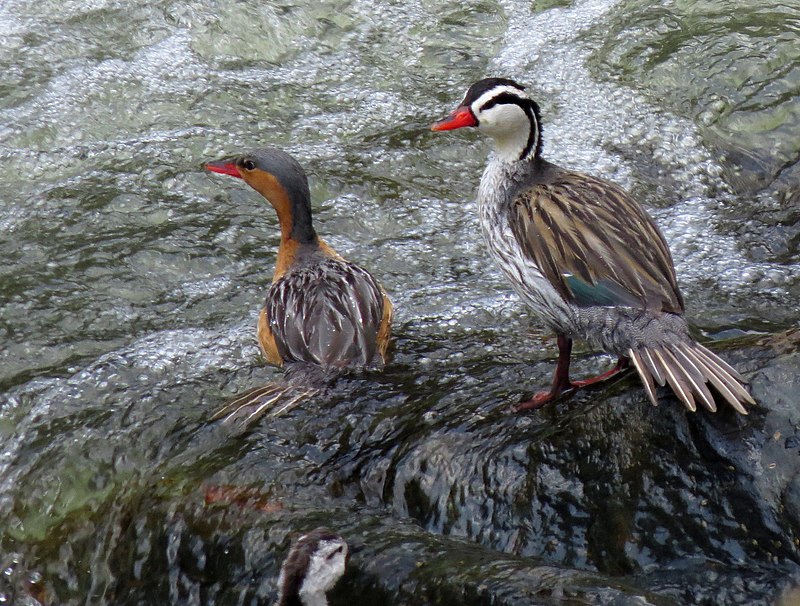
The Torrent Duck is a beautiful member of the duck, goose and swan family Anatidae. It is found in mountainous regions throughout South America and measures 43-46 centimetres long.
This unique species has its own genus – Merganetta armata – which belongs to the shelduck subfamily Tadorninae.
Its striking plumage includes dark brown feathers with varying shades from black to white on their wings, back and head as well as having yellow legs and feet.
They are mostly seen around fast flowing streams or small rivers where they feed mainly on aquatic invertebrates such as shrimp, insects, worms etc., but occasionally also take some plant material too.
These birds live in pairs for most of the year although during breeding season they may form larger groups or flocks when looking for food resources together.Scientific classification:
| Kingdom | Animalia |
| Phylum | Chordata |
| Class | Aves |
| Order | Anseriformes |
| Family | Anatidae |
| Genus | Merganetta Gould, 1842 |
| Species | M. armata |
15. Chilean Skua
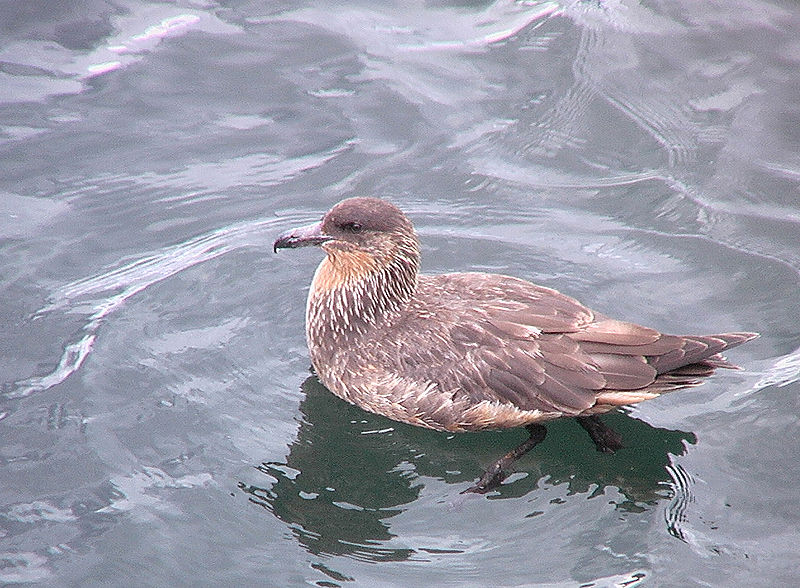
The Chilean skua is a large predatory seabird found in South America. It can be recognized by its dark cap that contrasts with the cinnamon colored throat and lower face.
These birds often wander as far north as Brazil and Peru when not breeding, but are primarily concentrated around Argentina and Chile.
Hybridization between this species of skua and brown skuas has been observed in southern Argentina.
The Chilean Skua measures approximately 55 cm long making it smaller than some other varieties of sea bird, however they make up for their size with aggression towards competitors or intruders near nesting areas.Scientific classification:
| Kingdom | Animalia |
| Phylum | Chordata |
| Class | Aves |
| Order | Charadriiformes |
| Family | Stercorariidae |
| Genus | Stercorarius |
| Species | S. chilensis |
16. Austral Pygmy Owl
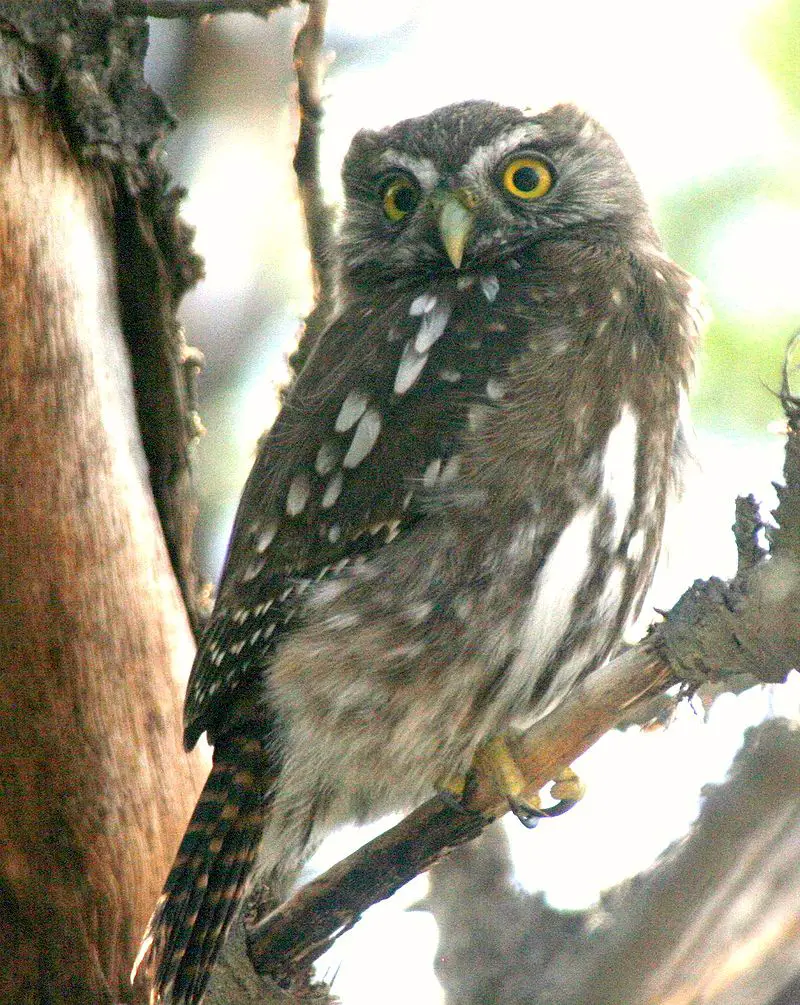
The Austral Pygmy Owl is a species of owl that resides in Argentina and Chile. It has sometimes been mistaken as a subspecies of Ferruginous Pygmy Owl, but DNA studies have proven it to be its own unique species.
Measuring up to 21 cm in length, the Austral Pygmy Owl has distinctive reddish-brown feathers with white spotting on its wings and tail.
Its eyes are bright yellow while its facial disc is striped brown or grey depending on the individual bird’s colouration patterning.
This small nocturnal hunter preys mostly on insects such as grasshoppers, crickets, moths and beetles which can often be found in open habitats like grasslands fields near water sources such as lakes or rivers where they also nest among trees for protection from predators during daylight hours.
The Austral Pygmy Owls are an important part of their local ecosystems providing insect control without harming other wildlife populations which makes them vital members of their environment.Scientific classification:
| Kingdom | Animalia |
| Phylum | Chordata |
| Class | Aves |
| Order | Strigiformes |
| Family | Strigidae |
| Genus | Glaucidium |
| Species | G. nana |
Also Featured In: Most Common Birds Found in Chile,
17. Austral Parakeet
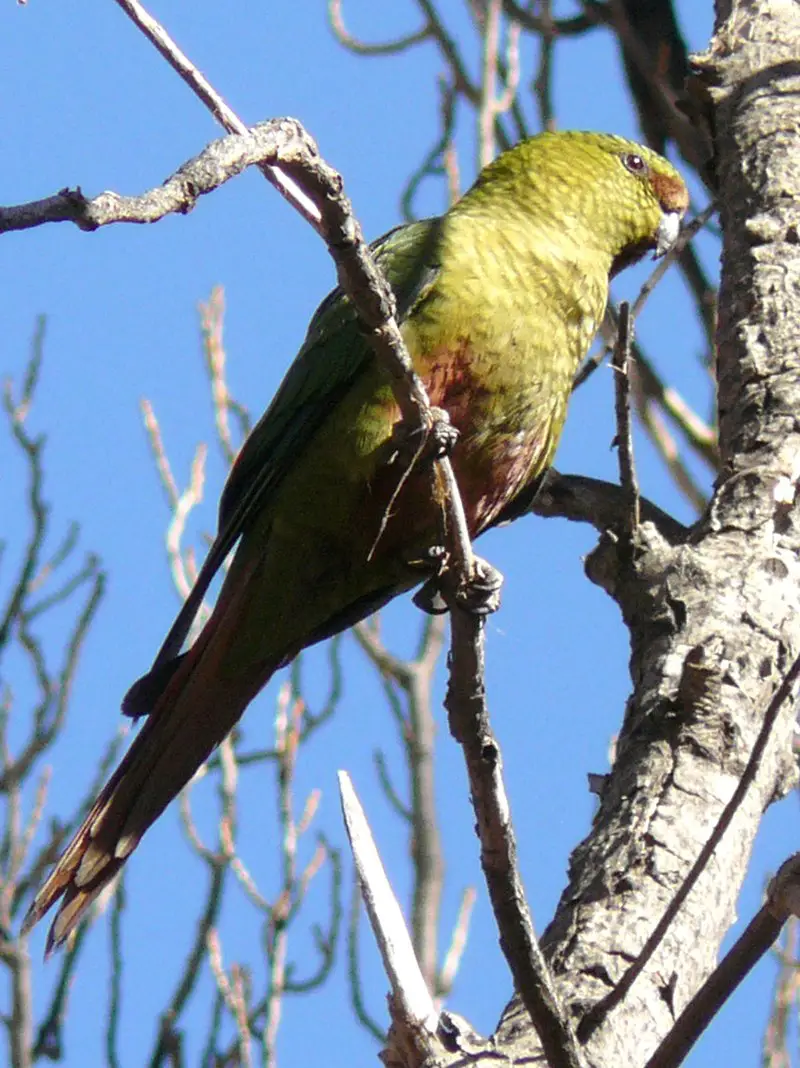
The Austral Parakeet, also known as the Emerald Parakeet or Austral Conure, is a beautiful bird native to South America. It has vibrant green plumage with light barring and some dull red on the forehead and lores.
This species can reach up to 35 cm in length – 2 cm larger than monk or quaker parakeets. Its range stretches from Argentina and Chile all the way north to Temuco.
These birds are highly social animals that live together in flocks of varying sizes depending on availability of food sources.
They feed mainly on seeds but will also consume fruit, berries and insects when available.
The Austral Parakeet is an intelligent species that bonds closely with its human keepers if provided enough enrichment activities like foraging toys and playtime outside their cage environment.Scientific classification:
| Kingdom | Animalia |
| Phylum | Chordata |
| Class | Aves |
| Order | Psittaciformes |
| Family | Psittacidae |
| Genus | Enicognathus |
| Species | E. ferrugineus |
18. Elegant Crested Tinamou
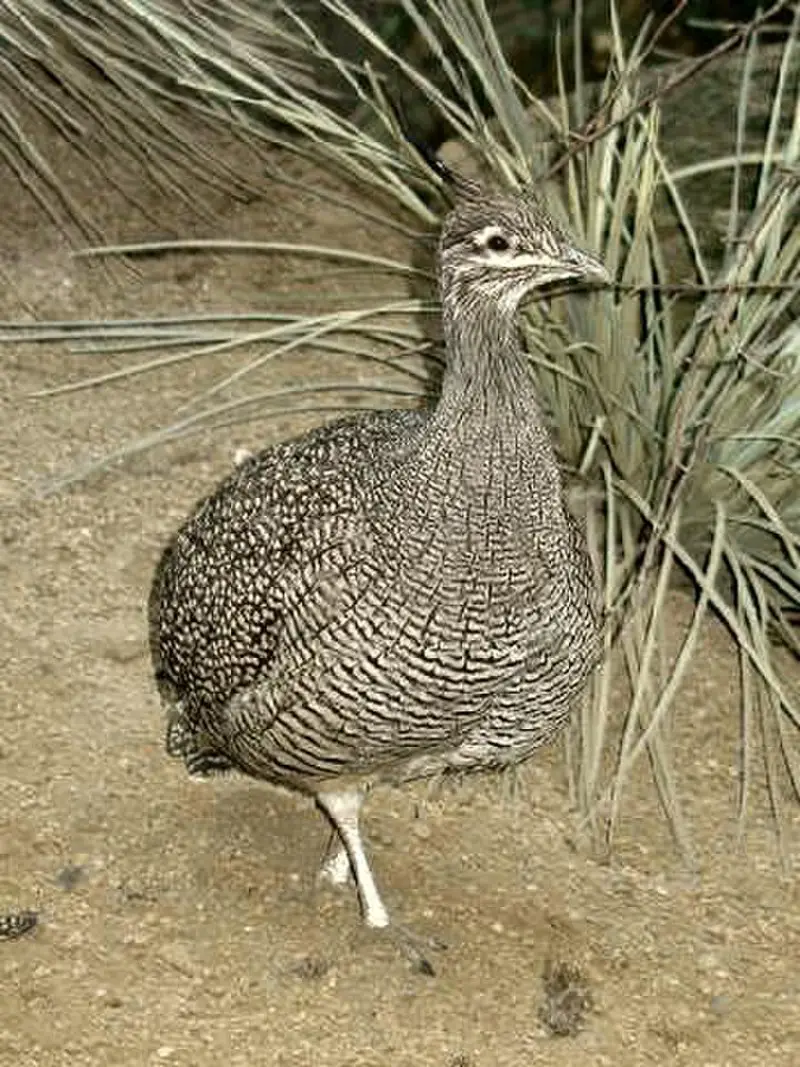
The elegant crested tinamou, or martineta tinamou (Eudromia elegans), is a medium-sized bird found in southern Chile and Argentina. This species has an omnivorous diet and is often seen on the ground due to its poor flying ability.
It has rounded wings that give it a partridge-like shape, with olive brown plumage being the main coloration of this bird.
Its most distinct feature however is its crest which gives it both elegance and distinction amongst other members of its family.
The populations for these birds have been slowly declining over time due to human activity such as habitat destruction but conservation efforts are underway in order to protect them from further decline.Scientific classification:
| Kingdom | Animalia |
| Phylum | Chordata |
| Class | Aves |
| Infraclass | Palaeognathae |
| Order | Tinamiformes |
| Family | Tinamidae |
| Genus | Eudromia |
| Species | E. elegans |
19. Upland Goose
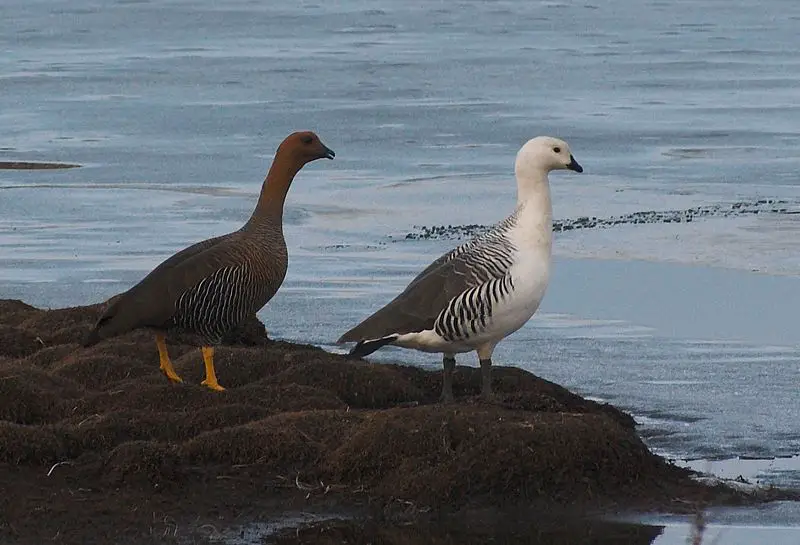
The Upland Goose, also known as the Magellan Goose, is a species of sheldgoose belonging to the Anatidae family.
With its similar habits and appearance to true geese, this bird has two recognized subspecies – Chloephaga picta leucoptera and C. p. picta which inhabit regions in South America such as Patagonia and Tierra del Fuego respectively.
They are highly sociable birds that live in small flocks or pairs on open grassland with access to water sources for bathing and twilight feedings when they hunt for food items like insects, worms or molluscs.
Their feathers range from brownish grey colours along their wings while white underparts give them an overall spotted effect making these birds very attractive creatures.Scientific classification:
| Kingdom | Animalia |
| Phylum | Chordata |
| Class | Aves |
| Order | Anseriformes |
| Family | Anatidae |
| Genus | Chloephaga |
| Species | C. picta |
20. Fire-Eyed Diucon
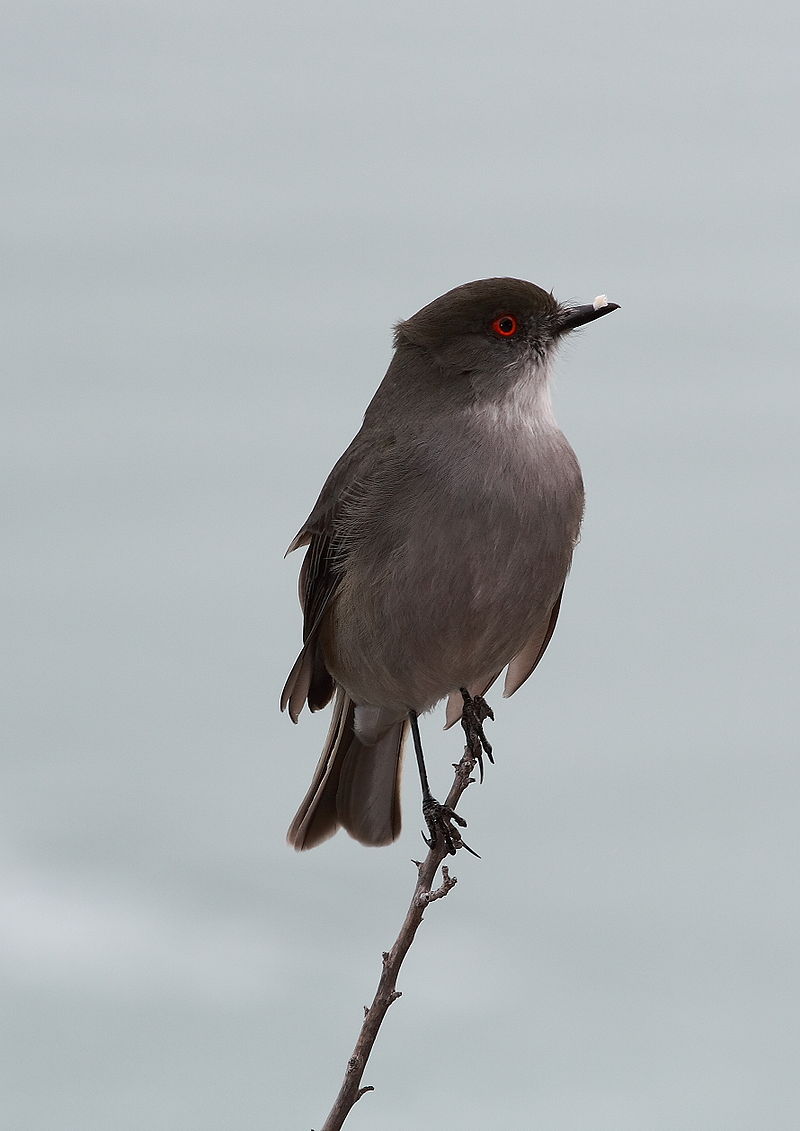
The Fire-eyed Diucon is a unique species of passerine bird belonging to the Tyrannidae family, found in Central and South America.
It has an impressive 19–21 cm length with grey upperparts and pale grey underparts with white throat and undertail coverts.
Its most distinct feature is its bright coral-red eyes, for which it was named after. The diucon also makes distinctive call sounds like ‘tche’ or ‘dzee’ that can be heard during all times of day as well as night, often repeated several times over in succession.
This beautiful creature lives mainly on insects but will sometimes make use of fruits when other food sources are scarce.
They prefer open areas such as shrubby hillsides and woodlands where they find plenty of their favourite snacks.Scientific classification:
| Kingdom | Animalia |
| Phylum | Chordata |
| Class | Aves |
| Order | Passeriformes |
| Family | Tyrannidae |
| Genus | Pyrope Cabanis & Heine, 1860 |
| Species | P. pyrope |
21. Westland Petrel
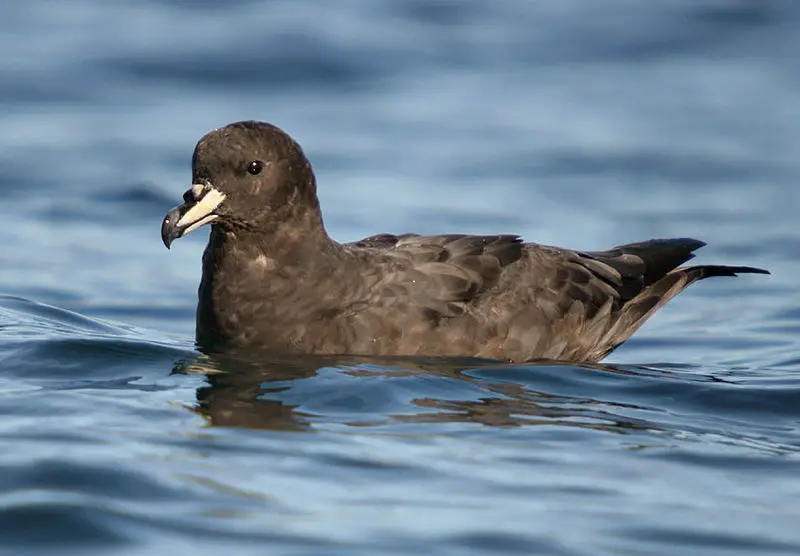
The Westland petrel is an endemic species to New Zealand, belonging to the Procellariidae family of seabirds. It has a stocky build and weighs around 1,100 grams (39 oz), making it one of the largest burrowing petrels.
Its dark blackish-brown feathers are complemented by its distinctively black bill and feet.
It breeds on islands off both coasts of South Island in summertime before migrating northwards for winter feeding grounds further offshore away from land.
The species feeds mainly on squid but also takes small fish such as herring or pilchard when available close enough to shorelines where they breed.
They feed at night using their sense of smell combined with sonar like clicks produced from their bills which helps them locate food beneath surface waters many meters deep underwater during darkness hours only illuminated by moonlight reflections upon waves above .Scientific classification:
| Kingdom | Animalia |
| Phylum | Chordata |
| Class | Aves |
| Order | Procellariiformes |
| Family | Procellariidae |
| Genus | Procellaria |
| Species | P. westlandica |
Also Featured In: New Zealand Birds, Most Common Birds in Stewart Island
22. Yellow Cardinal
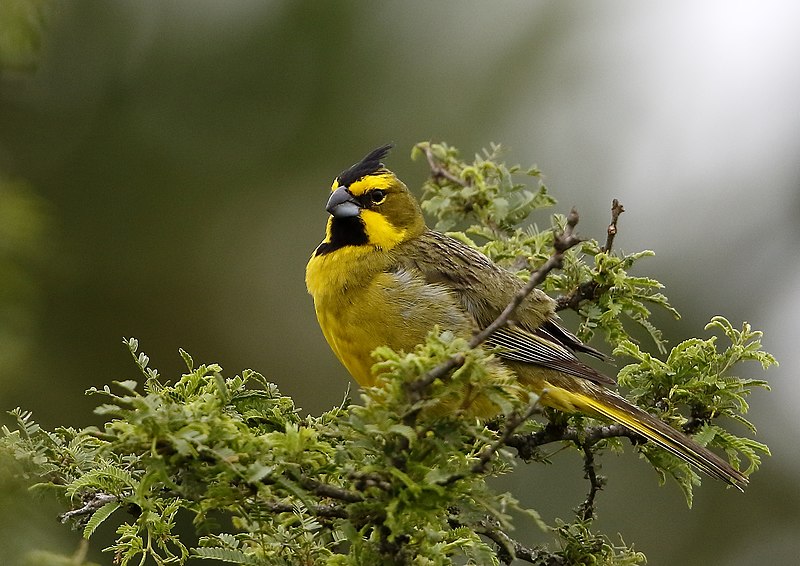
The Yellow Cardinal is a species of bird found in South America, and is the only member of its genus. It has bright yellow plumage and black wings with white tips – giving it an unmistakable appearance.
Its habitat includes open woodlands and grassland areas, where it feeds on seeds from native plants as well as fruits such as bananas.
The population size for this species is small due to hunting pressure, but conservation efforts are beginning to help increase numbers.
This rare beauty was first described by French ornithologist Louis Jean Pierre Vieillot in 1817 under the binomial name Coccothraustes cristata; since then they have captivated people’s hearts all over the world.Scientific classification:
| Kingdom | Animalia |
| Phylum | Chordata |
| Class | Aves |
| Order | Passeriformes |
| Family | Thraupidae |
| Genus | Gubernatrix Lesson, 1837 |
| Species | G. cristata |
Also Featured In: Uruguay birds,
23. Rufous-Collared Sparrow
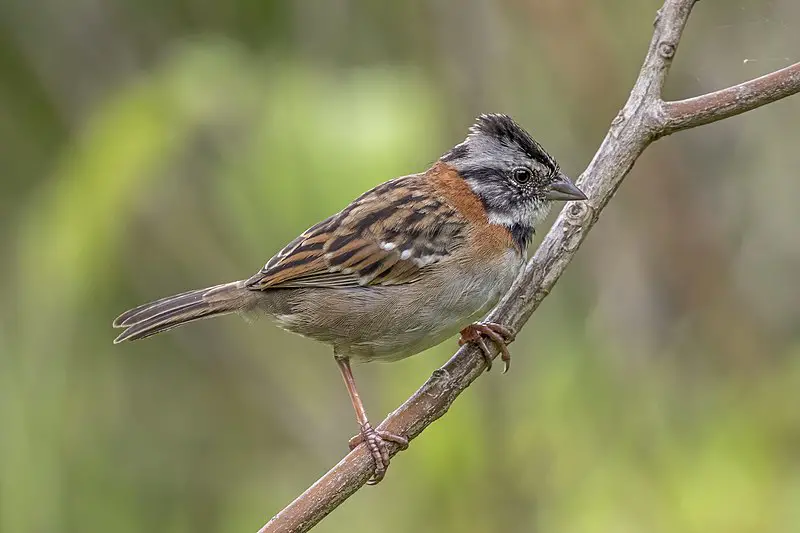
The Rufous-collared Sparrow, also known as the Andean sparrow, is a common bird found in open habitats from Mexico to Tierra del Fuego.
It has distinctive brown and white streaks on its back, with a reddish collar around its neck.
This species can be heard singing throughout much of the year and their vocalizations have been studied extensively since the 1970s.
They are omnivorous birds that feed mainly on seeds but will also consume insects for protein during breeding season.
The Rufous-collared sparrow often lives near humans and is an important part of many ecosystems across South America due to its role in helping disperse plant seeds including those used by people for food or livestock fodder production.Scientific classification:
| Kingdom | Animalia |
| Phylum | Chordata |
| Class | Aves |
| Order | Passeriformes |
| Family | Passerellidae |
| Genus | Zonotrichia |
| Species | Z. capensis |
24. Wandering Albatross
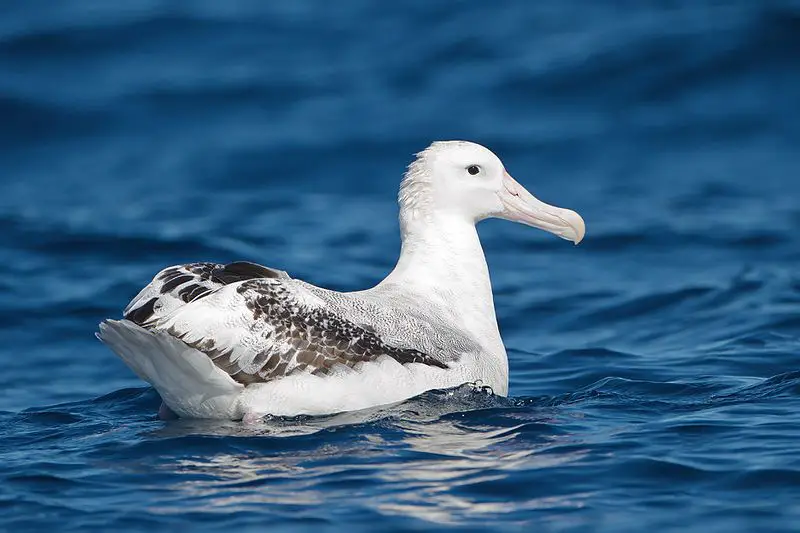
The Wandering Albatross is a large seabird from the family Diomedeidae found in the Southern Ocean. It has white wings, black tips and a long hooked bill.
With its impressive wingspan of up to 3m they are one of largest birds that can fly.
They spend most their lives far out at sea only coming to land for breeding season on remote islands where they nest on cliffs or rocky areas close by the ocean.
The species was first described in 1783 but had been considered similar to other albatrosses such as Tristan Albatross and Antipodean Albatross until recently when it was recognized as an individual species due to genetic studies showing differences between them.Scientific classification:
| Kingdom | Animalia |
| Phylum | Chordata |
| Class | Aves |
| Order | Procellariiformes |
| Family | Diomedeidae |
| Genus | Diomedea |
| Species | D. exulans |
Also Featured In: Antarctica Birds, Birds You’ll Find in the Sea
25. Black-Browed Albatross
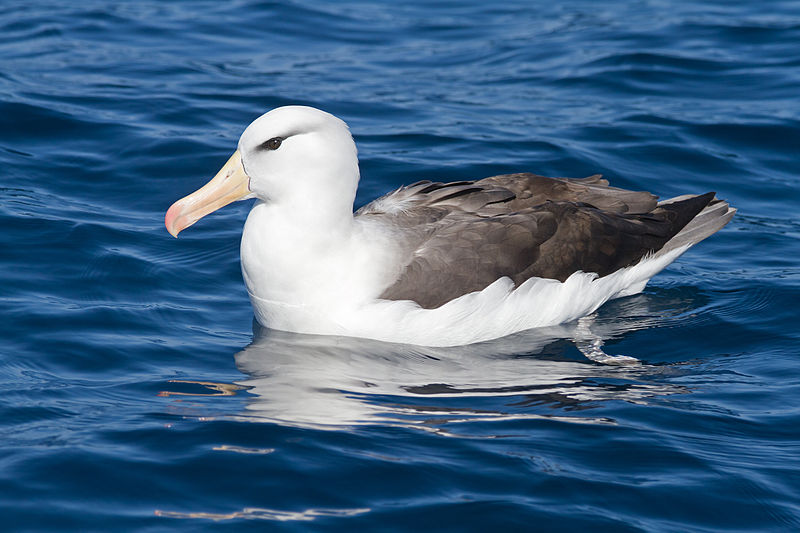
The Black-browed Albatross is a majestic seabird that belongs to the albatross family known as Diomedeidae.
It is an impressive bird, with its black beak and brow contrasting against white plumage on its wings and body.
The most widespread and common member of this group, it can often be seen flying around oceans in different parts of the world.
These birds share many features with other members of their order Procellariiformes, such as shearwaters, fulmars, storm petrels and diving petrels; they all have long wingspans for gliding effortlessly above water surfaces.
They feed mainly by scavenging or hunting small fish near sea surface while flying low over waters.
Its population has unfortunately declined due to commercial fishing vessels which attract them closer to shore resulting in entanglement into fishing nets leading them towards mortality.Scientific classification:
| Kingdom | Animalia |
| Phylum | Chordata |
| Class | Aves |
| Order | Procellariiformes |
| Family | Diomedeidae |
| Genus | Thalassarche |
| Species | T. melanophris |
Also Featured In: Birds that Live in the Ocean , Birds that Live around Victoria
26. King Penguin
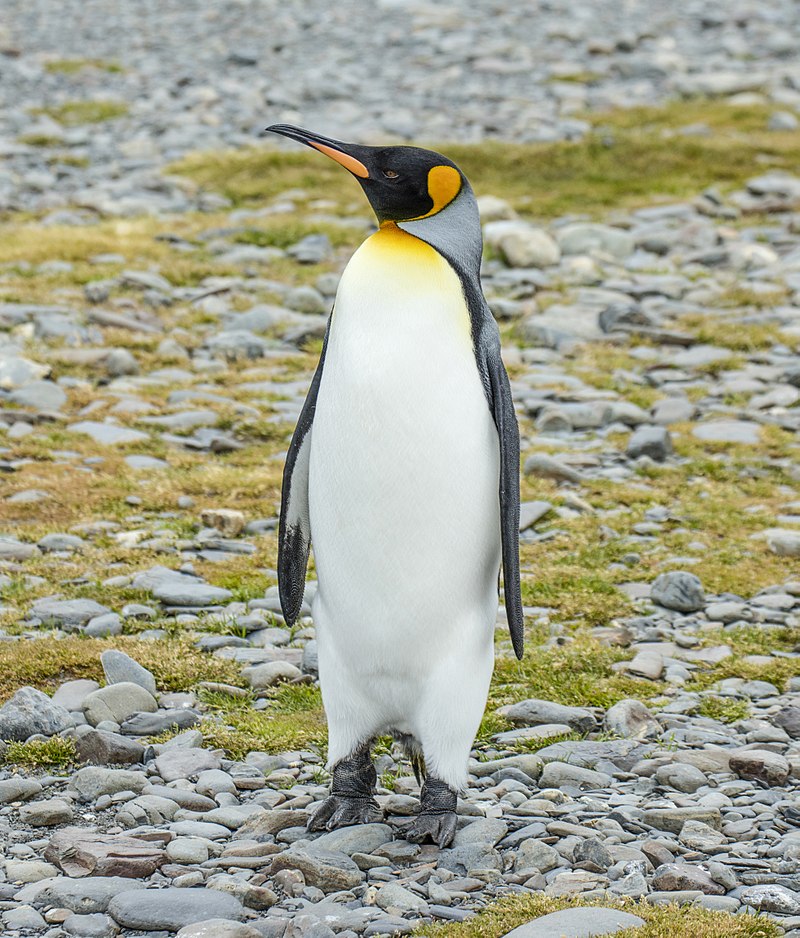
King penguins are majestic birds that live in the temperate and sub-Antarctic regions of the South Atlantic and Indian Oceans.
They stand up to 3 feet tall, making them smaller than their relative, the Emperor Penguin.
King Penguins have a distinctive two toned orange and black plumage with white markings on its face around its eyes which gives it an elegant look.
Unlike other species of penguin, they don’t migrate as much but stay close to breeding grounds year round living off from fish and squid found near shorelines or ice floes.
Their diet also consists of krill shrimp, small crustaceans such as copepods or amphipods eaten whole along with some occasional planktonic organisms like jellyfish for variety.
King Penguins form large colonies where males take part in incubation duties while females feed at sea for weeks at a time during mating season.Scientific classification:
| Kingdom | Animalia |
| Phylum | Chordata |
| Class | Aves |
| Order | Sphenisciformes |
| Family | Spheniscidae |
| Genus | Aptenodytes |
| Species | A. patagonicus |
27. Southern Royal Albatross
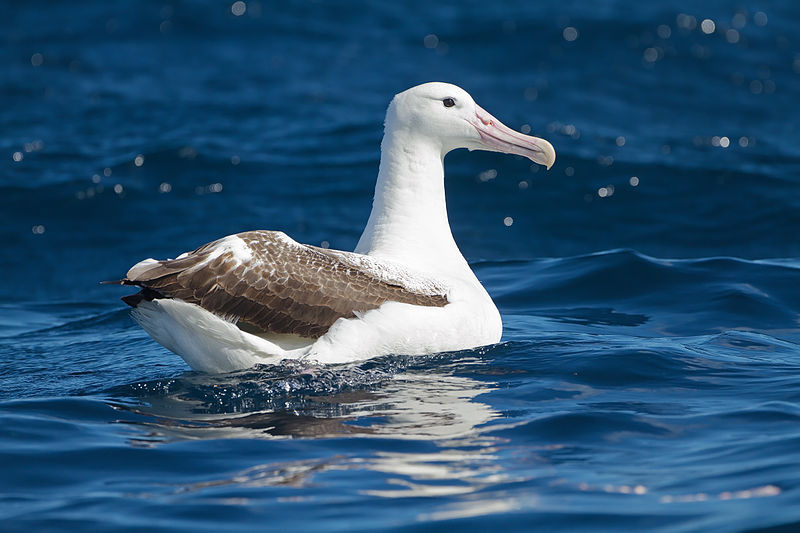
The Southern Royal Albatross, or Toroa, is an impressive sight. With a wingspan of 3 meters (9.8 feet), it’s one of the two largest species of albatross in the world alongside its close relative – the Wandering Albatross.
Recent studies have shown that it may even be larger than its cousin when taking mass into account and with similar wingspans too.
The bird has grey-brown plumage on both its head and body while they have white underparts plus black tips to their wings which can easily recognize from far away.
They are highly social birds who often congregate together before setting off for long journeys; during these trips, they rely heavily on oceanic winds for support as well as thermal uplift beneath them to stay airborne without expending energy flying themselves.Scientific classification:
| Kingdom | Animalia |
| Phylum | Chordata |
| Class | Aves |
| Order | Procellariiformes |
| Family | Diomedeidae |
| Genus | Diomedea |
| Species | D. epomophora |
28. White-Chinned Petrel
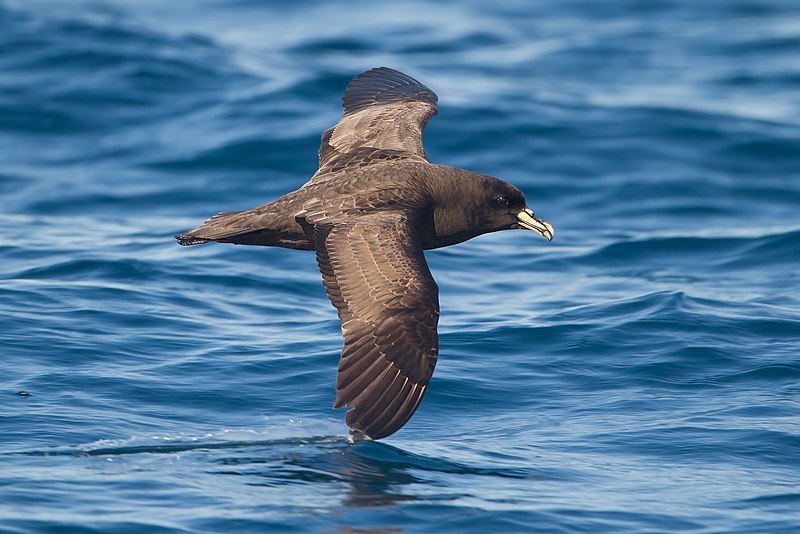
The White-chinned Petrel is a large seabird belonging to the Procellariidae family. It can be found in oceans around the Southern Hemisphere, ranging from Australia to Peru and Namibia.
These birds breed colonially on scattered islands and are sometimes known as Cape hens or Shoemakers.
They have unique white chins that distinguish them from other petrels, such as their former conspecies Spectacled Petrel.
Their wingspan averages about 115 cm across and they travel up to 4400 km during migration season.
The White-chinned Petrel feeds mainly on small fish, squid and zooplankton; it dives into the ocean for its prey using its strong webbed feet.
This species has an impressive lifespan of more than 35 years – making these majestic creatures some of our oldest avian companions.Scientific classification:
| Kingdom | Animalia |
| Phylum | Chordata |
| Class | Aves |
| Order | Procellariiformes |
| Family | Procellariidae |
| Genus | Procellaria |
| Species | P. aequinoctialis |
Also Featured In: Passage Islands Birds You Should Know, Welcome Islands Birds You Need To Know
29. Northern Giant Petrel
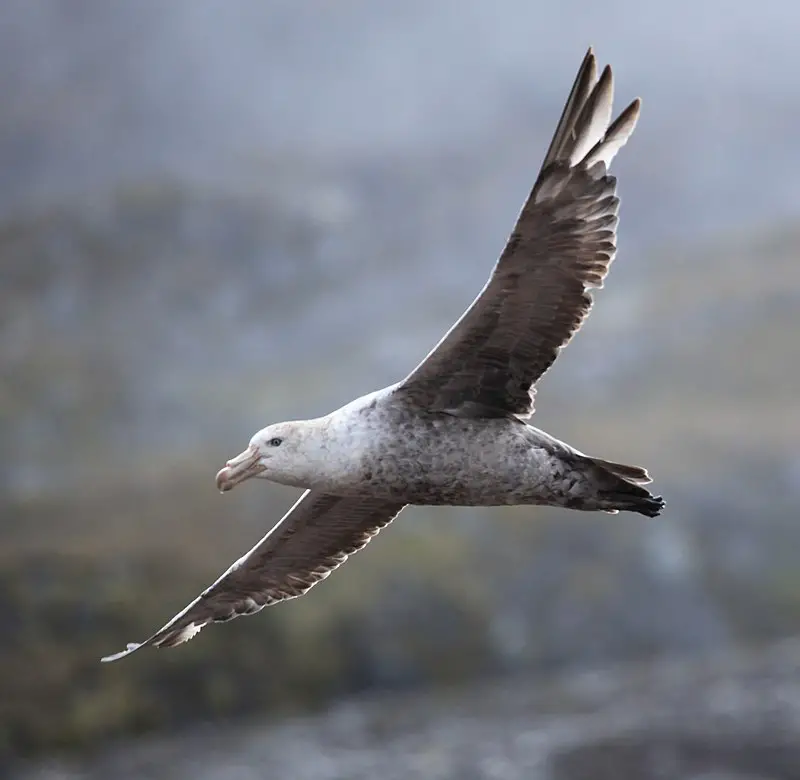
The Northern Giant Petrel is a large seabird of the southern oceans and belongs to the Macronectes family. It has broad distribution, overlapping with that of its cousin -the Southern Giant Petrel- but slightly northward.
First described in 1912 by Australian ornithologist Gregory Mathews as a subspecies of the Southern Giant Petrel, it reaches up to 75 cm long and weighs 3 kg on average.
Its plumage is dark grey above while white below, having black bill tipped with yellow or pink color along an orange line running from base to tip; its feet are also bright yellowish-orange in hue.
This species feeds mainly on fish and squid near coastal waters or scavenges carcasses farther away out at sea during winter months when food sources become scarce closer inland.Scientific classification:
| Kingdom | Animalia |
| Phylum | Chordata |
| Class | Aves |
| Order | Procellariiformes |
| Family | Procellariidae |
| Genus | Macronectes |
| Species | M. halli |
Also Featured In: Birds that Live in Gold Coasts, South Shetland Islands Birds You Need To Know
30. Austral Thrush
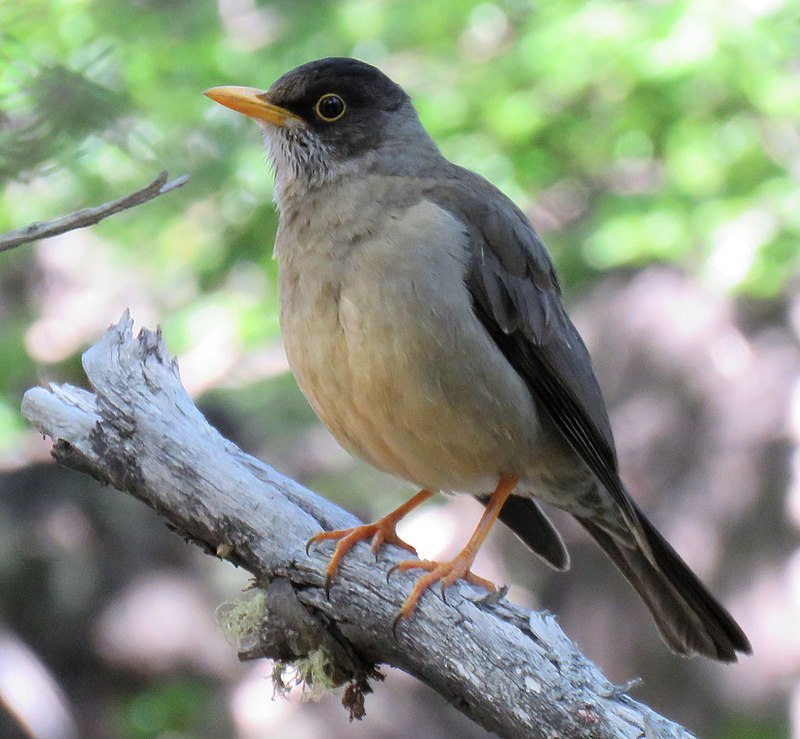
The Austral Thrush is a beautiful bird, native to Southern South America and the Falkland Islands.
It has a black body with white spots on its wings, yellow bill and feet, along with orange eyes which make it very distinctive.
The two subspecies of this bird are known as the Magellan thrush (T.f magellanicus) from southern Argentina and Chile; while the other subspecies is called the Falkland thrush (T.f falcklandii).
This species makes its habitat in thickets or open woodland areas where they feed mainly on insects by foraging through leaf litter such as worms or millipedes etc., They also consume fruits available in their environment too.
These birds form monogamous pairs during breeding season that breed once a year producing 3-4 eggs at most each time but usually only one survives due to competition among siblings when food resources become scarce.Scientific classification:
| Kingdom | Animalia |
| Phylum | Chordata |
| Class | Aves |
| Order | Passeriformes |
| Family | Turdidae |
| Genus | Turdus |
| Species | T. falcklandii |
Also Featured In: Thrush Species, Common Birds that Live around Ushuaia
31. Silvery Grebe
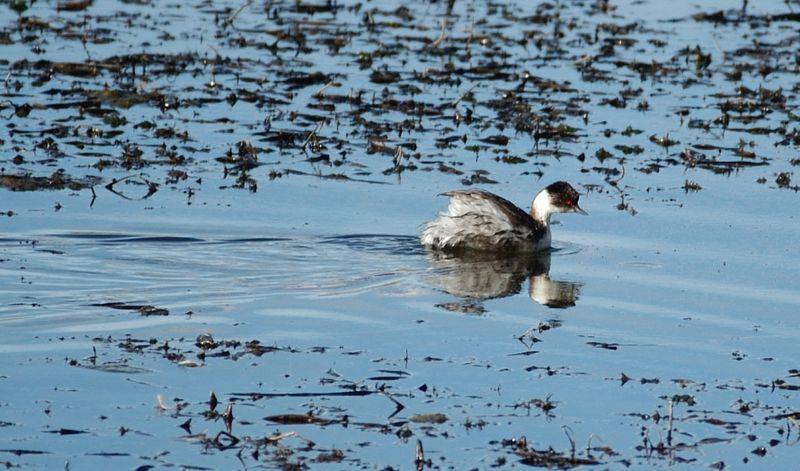
The Silvery Grebe is a freshwater bird found in the western and southern parts of South America. It can survive in altitudes of up to 4,000 metres and is even known to feed in saline lakes.
Measuring about 28 cm in length, this bird has two different subspecies with varying coloring on their heads.
The Silvery Grebe mainly feeds on small fish, crustaceans and aquatic vegetation.
Their natural habitat is freshwater lakes where they build their nests among aquatic plants. The Silvery Grebe has a unique appearance with a silvery-gray plumage and red eyes.
They are usually seen swimming on the surface of the water or diving to forage for food.
Their conservation status is currently listed as Least Concern.Scientific classification:
| Kingdom | Animalia |
| Phylum | Chordata |
| Class | Aves |
| Order | Podicipediformes |
| Family | Podicipedidae |
| Genus | Podiceps |
| Species | P. occipitalis |
Also Featured In: Silver Birds You Should Know, Falkland Islands Birds You Need To Know
32. Long-Tailed Meadowlark
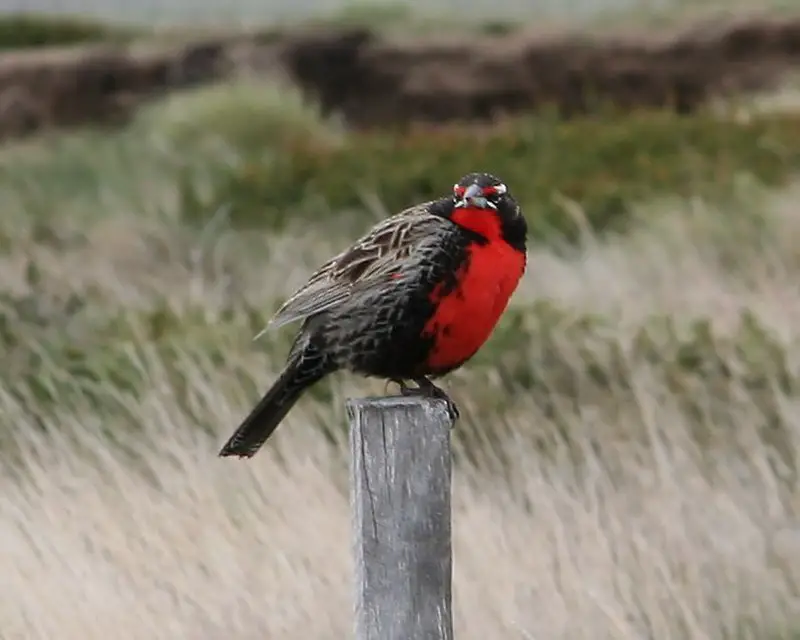
The Long-tailed meadowlark is a beautiful passerine bird found in southern South America and the Falkland Islands. The bird is approximately 25 to 28 cm long with a long, pointed bill and a fairly long tail.
The male species is predominantly dark brown with blackish streaking, while the female has a duller brown color. The Long-tailed meadowlark belongs to the meadowlark genus Leistes and falls under the icterid family.
Interestingly, this species is very similar in appearance to the endangered Pampas meadowlark.
These birds can be found in grasslands, agricultural fields, and open habitats with low shrubs. They are primarily insectivorous, feeding on insects and other small invertebrates.
The Long-tailed meadowlark has a beautiful song that sounds like a melodious whistle, which is audible from a distance.
Although they are not classified as endangered, habitat loss due to human activities is a threat to their populations.Scientific classification:
| Kingdom | Animalia |
| Phylum | Chordata |
| Class | Aves |
| Order | Passeriformes |
| Family | Icteridae |
| Genus | Leistes |
| Species | L. loyca |
Also Featured In: Birds That Live around East Falkland, Native Birds Of West Falkland
33. Patagonian Sierra Finch
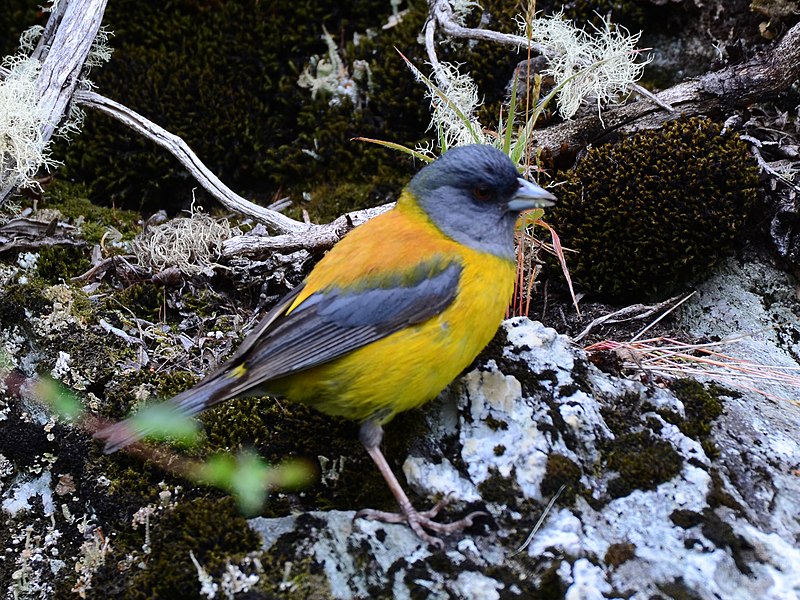
The Patagonian sierra finch is a species of bird that can be found in Argentina and Chile. It typically resides in temperate forests, subtropical or tropical dry shrubland, and temperate grassland.
Its diet consists of seeds, flower parts, nectar, fruit, and insects.
However, it has also been known to forage on human refuse. This bird belongs to the Thraupidae family and is known for its unique and colorful appearance.
With its diverse diet and adaptable nature, the Patagonian sierra finch has managed to thrive in diverse environments.Scientific classification:
| Kingdom | Animalia |
| Phylum | Chordata |
| Class | Aves |
| Order | Passeriformes |
| Family | Thraupidae |
| Genus | Phrygilus |
| Species | P. patagonicus |
Also Featured In: Common Birds in Chiloé Island,
34. Patagonian Mockingbird
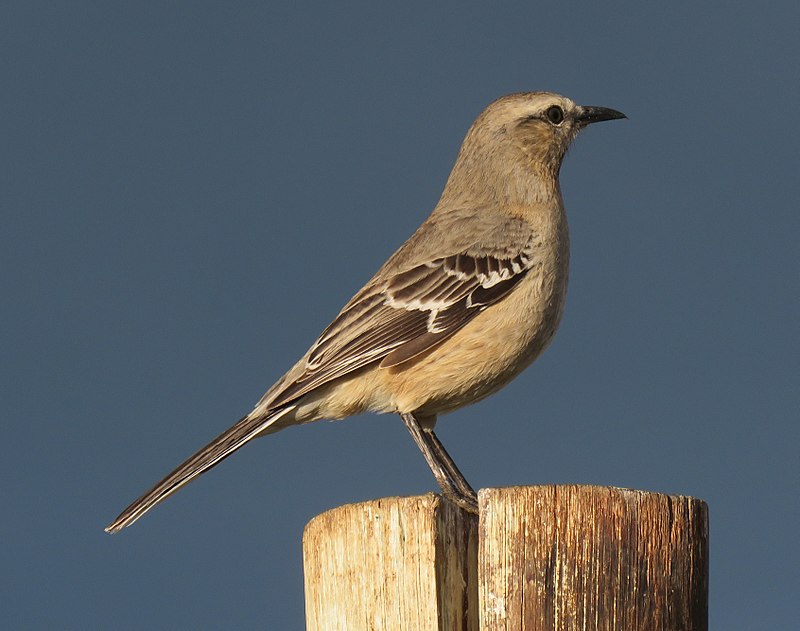
The Patagonian mockingbird is a species of bird in the Mimidae family, found in Argentina and Chile. It is closely related to the Chilean mockingbird, according to some taxonomists.
However, this relationship is not universally agreed upon. The Patagonian mockingbird is known for its ability to mimic other bird species and even some non-bird sounds. Its diet consists mainly of insects and fruits.
This bird is generally non-migratory, but some individuals may move to lower altitudes during the winter.
The Patagonian mockingbird can often be found in open grasslands and shrublands. The species is not considered to be threatened and has a large range.Scientific classification:
| Kingdom | Animalia |
| Phylum | Chordata |
| Class | Aves |
| Order | Passeriformes |
| Family | Mimidae |
| Genus | Mimus |
| Species | M. patagonicus |
35. Steamer Duck
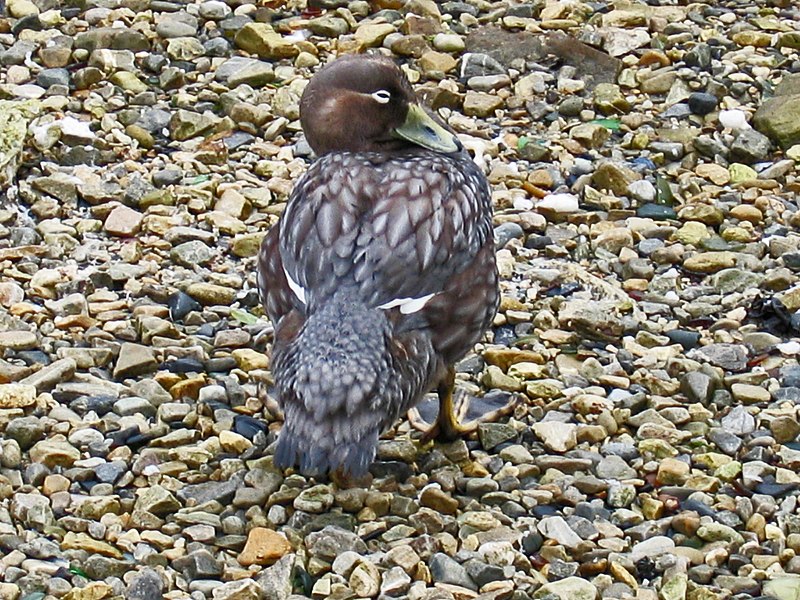
The steamer duck is a unique species of duck found only in the southern cone of South America in Chile and Argentina. This type of duck is known for being flightless, except for one species that can fly but rarely takes to the air.
The steamer duck is very aggressive and will even chase off predators like petrels. They are capable of bloody battles and are not to be underestimated. In fact, they have been known to use their strong wings to attack humans who come too close.
Despite their ferocity, these ducks are still admired for their unique characteristics and their ability to adapt to harsh environments. The steamer duck is truly a remarkable bird and a proud symbol of South America.Scientific classification:
| Kingdom | Animalia |
| Phylum | Chordata |
| Class | Aves |
| Order | Anseriformes |
| Family | Anatidae |
| Subfamily | Tadorninae |
| Genus | Tachyeres Owen, 1875 |
36. Two-Banded Plover
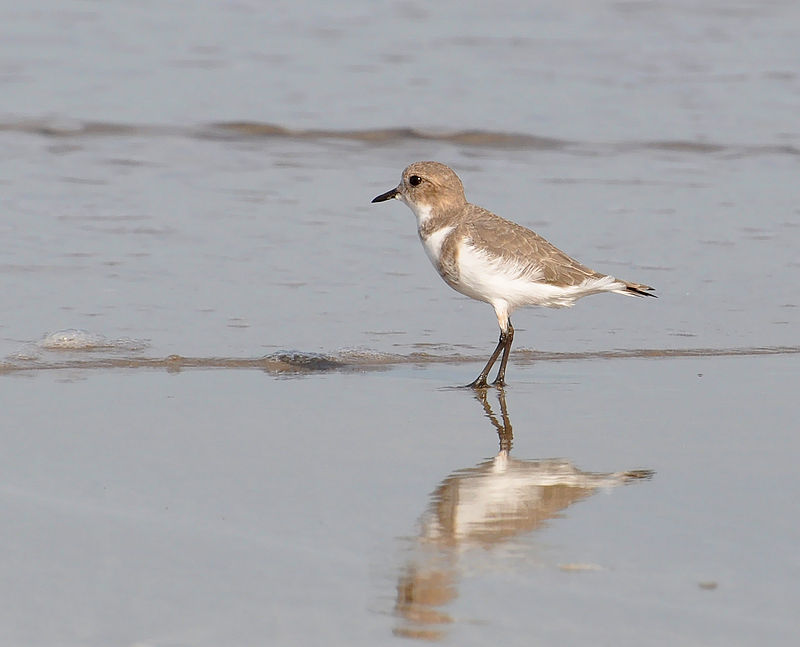
The Two-banded plover bird is a member of the Charadriidae family’s Charadriinae subfamily. It can be found in various countries, including Uruguay, Brazil, Argentina, Chile, and the Falkland Islands.
Some experts consider the Two-banded plover and its similar-looking relative, the Puna plover, as a superspecies. Both of these birds look similar, but the latter is monotypic and found mainly on the mainland.
The Two-banded plover bird is a delightful species of bird that is cherished by bird enthusiasts all over the world.Scientific classification:
| Kingdom | Animalia |
| Phylum | Chordata |
| Class | Aves |
| Order | Charadriiformes |
| Family | Charadriidae |
| Genus | Charadrius |
| Species | C. falklandicus |
37. Chimango Caracara
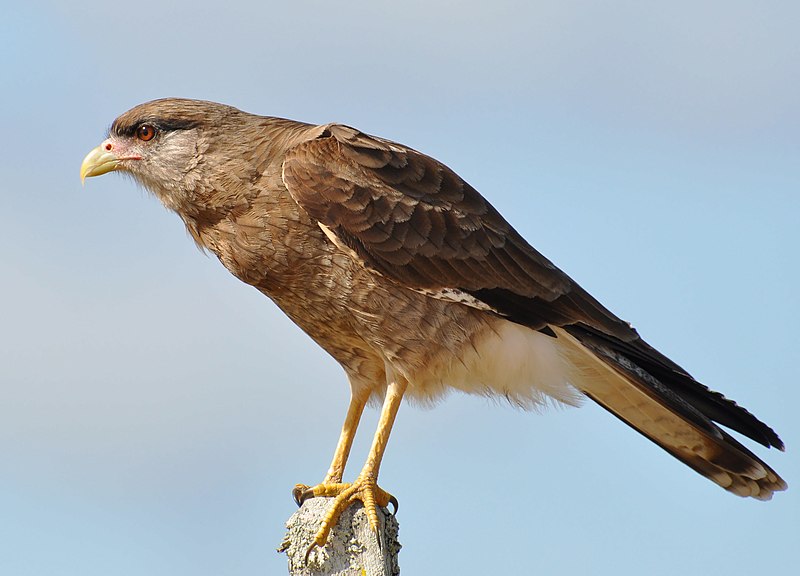
The chimango caracara is a bird of prey belonging to the falconidae family found in South American countries like Argentina, Bolivia, Brazil, Chile, Paraguay, and Uruguay.
It is also known to be a vagrant on the Falkland Islands. The taxonomy of caracaras is still unresolved, and the placement of the chimango caracara in the falconidae family is disputed.
This bird species has distinct physical features, including a white throat, chestnut body, and long hooked beak, used to hunt for small mammals, insects, and other birds.
The population of the chimango caracara is believed to be stable, and the bird is one of the most studied raptors in South America.
Overall, the chimango caracara is an important predatory bird species in South America that plays an essential role in the ecosystem.Scientific classification:
| Kingdom | Animalia |
| Phylum | Chordata |
| Class | Aves |
| Order | Falconiformes |
| Family | Falconidae |
| Genus | Milvago |
| Species | M. chimango |
Also Featured In: Easter Island Birds You Should Know,
38. Black-Faced Ibis
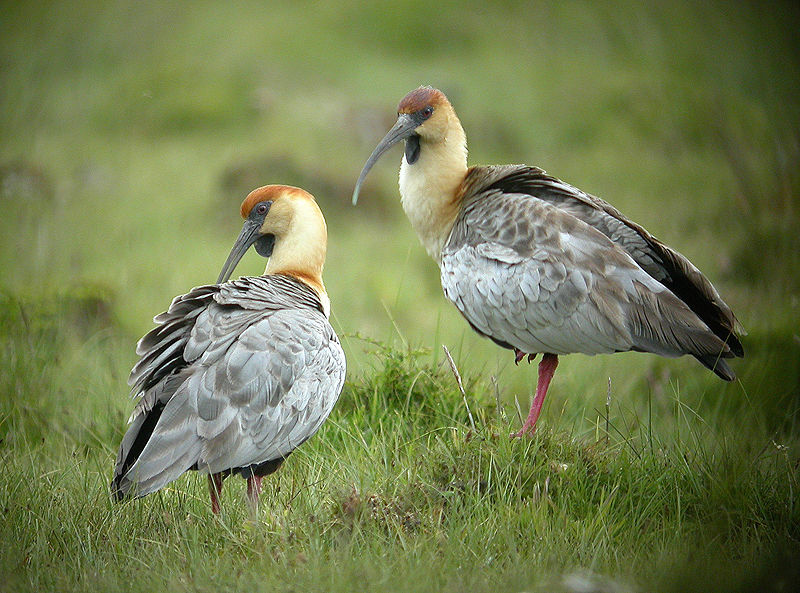
The black-faced ibis is a bird species belonging to the Threskiornithidae family. It is commonly found in grasslands and fields in southern and western parts of South America.
Although it was previously considered a subspecies of buff-necked ibis, recent studies have confirmed their separate identity. The Andean ibis is also considered a subspecies of the black-faced ibis.
These birds are known for their distinct black facial feathers, and they have a long and curved bill used for foraging. They feed on a variety of small animals including insects, lizards, and small rodents.
Black-faced ibis are highly social and typically roost in groups. They are not considered endangered, although habitat loss poses a potential threat to their populations.Scientific classification:
| Kingdom | Animalia |
| Phylum | Chordata |
| Class | Aves |
| Order | Pelecaniformes |
| Family | Threskiornithidae |
| Genus | Theristicus |
| Species | T. melanopis |
39. Thorn-Tailed Rayadito
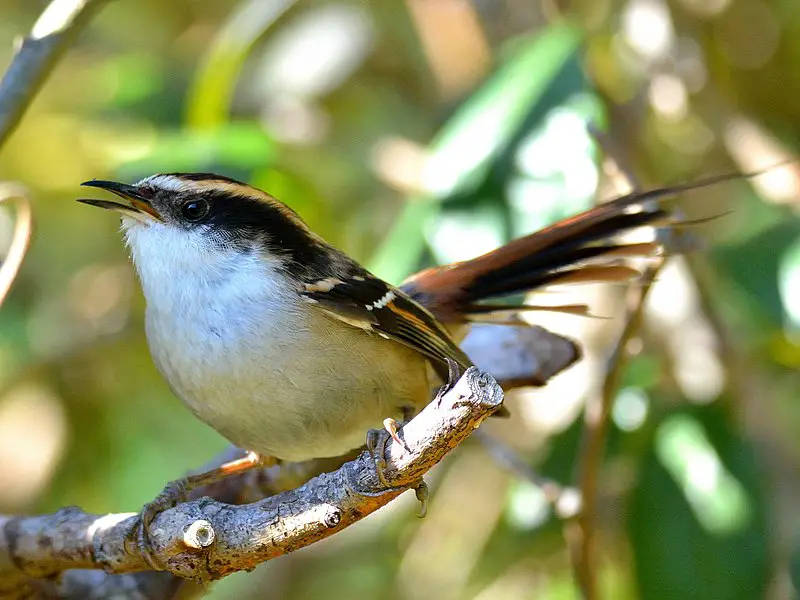
The thorn-tailed rayadito is a well-known bird found in temperate forests and subtropical dry shrubland. This bird belongs to the family Furnariidae and is primarily found in southern Chile, south of 30°S.
While some sources suggest it may have once been present in the Falkland Islands, this has not been confirmed.
Despite its limited range, the thorn-tailed rayadito is the most commonly recognized bird in the temperate forests of the Zona Austral and Zona Sur in Chile.
With its distinctive appearance, including a pointed tail and brown and white plumage, it is easily recognizable to birdwatchers and other observers.
While it is not considered endangered, the thorn-tailed rayadito is an important part of the local ecosystem and plays a crucial role in helping to disperse seeds and control insect populations.Scientific classification:
| Kingdom | Animalia |
| Phylum | Chordata |
| Class | Aves |
| Order | Passeriformes |
| Family | Furnariidae |
| Genus | Aphrastura |
| Species | A. spinicauda |
40. Austral Negrito
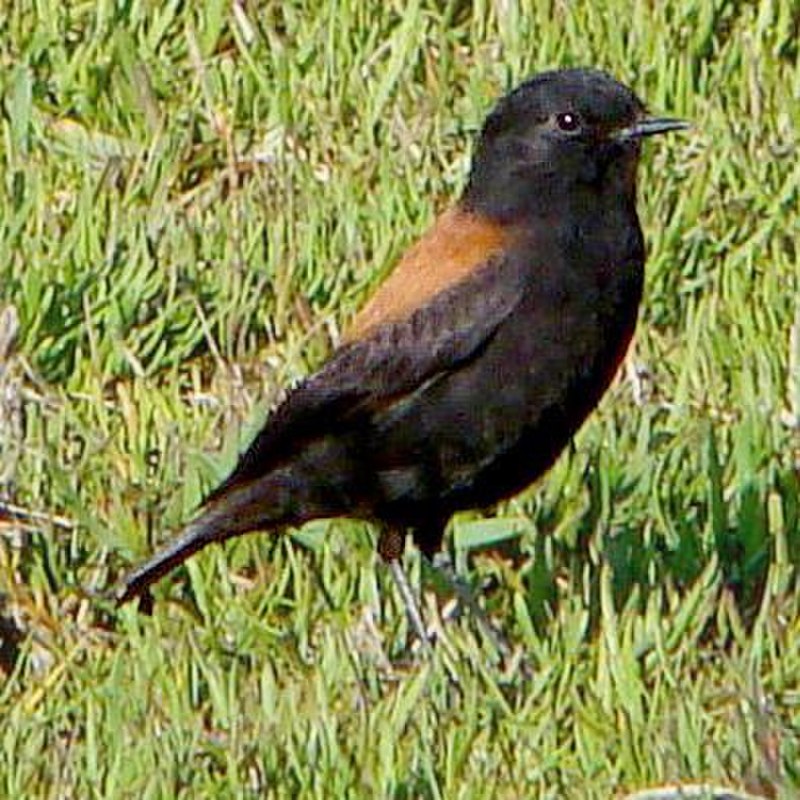
The Austral Negrito, also known as the Patagonian Negrito, is a species of bird that belongs to the Tyrannidae family.
It can be found breeding in Argentina and Chile, while migrating north to countries such as Bolivia, Brazil, Paraguay, and Uruguay.
Although it is a vagrant to the Falkland Islands and the South Georgia and South Sandwich Islands, it has also been seen in the South Shetland Islands.
The bird’s natural habitats include forests, shrublands, and grasslands. In terms of physical features, the Austral Negrito has a dark brown coloration with a white throat, a small bill, and a broad tail.
Its diet mainly consists of insects and small vertebrates. Like other migratory birds, the Austral Negrito’s movements are influenced by environmental changes, making it an important indicator of ecosystem health.Scientific classification:
| Kingdom | Animalia |
| Phylum | Chordata |
| Class | Aves |
| Order | Passeriformes |
| Family | Tyrannidae |
| Genus | Lessonia |
| Species | L. rufa |
41. Buff-Winged Cinclodes
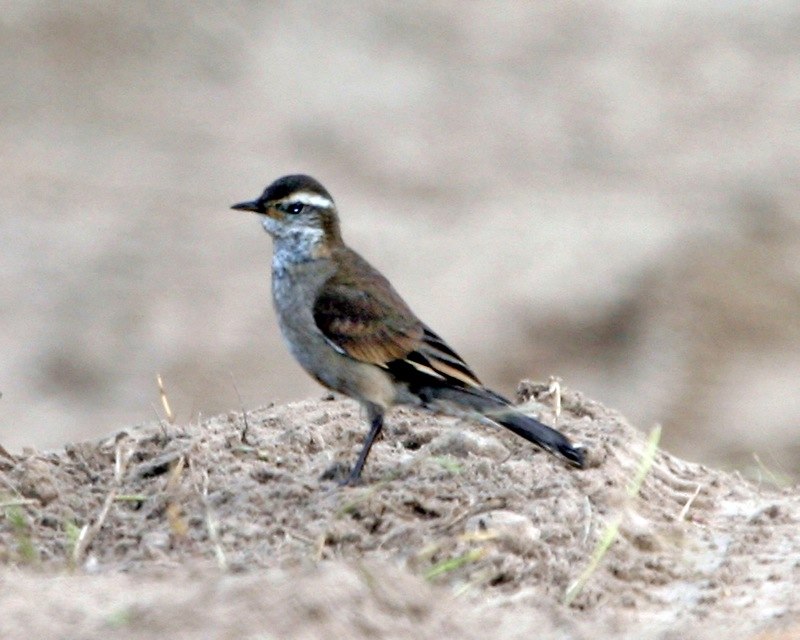
The Buff-winged cinclodes is a bird species of the Furnariidae family. It is found in eastern Chile and Argentina, and during winters it can be found in the Pampas.
It is known for its distinctive buff wings. This bird prefers to stay in subtropical or tropical high-altitude shrubland, temperate grassland, and subtropical or tropical high-altitude grassland habitats.
This species was formerly considered a subspecies of the bar-winged cinclodes.
The Buff-winged cinclodes is a small and striking bird that is known for its beautiful plumage. It is a natural part of the ecosystem and contributes to the balance of the environment.
Like many bird species, it plays an important role in pollination and seed dispersal. Its presence is essential for maintaining a healthy ecosystem.Scientific classification:
| Kingdom | Animalia |
| Phylum | Chordata |
| Class | Aves |
| Order | Passeriformes |
| Family | Furnariidae |
| Genus | Cinclodes |
| Species | C. fuscus |
42. Black-Throated Huet-Huet
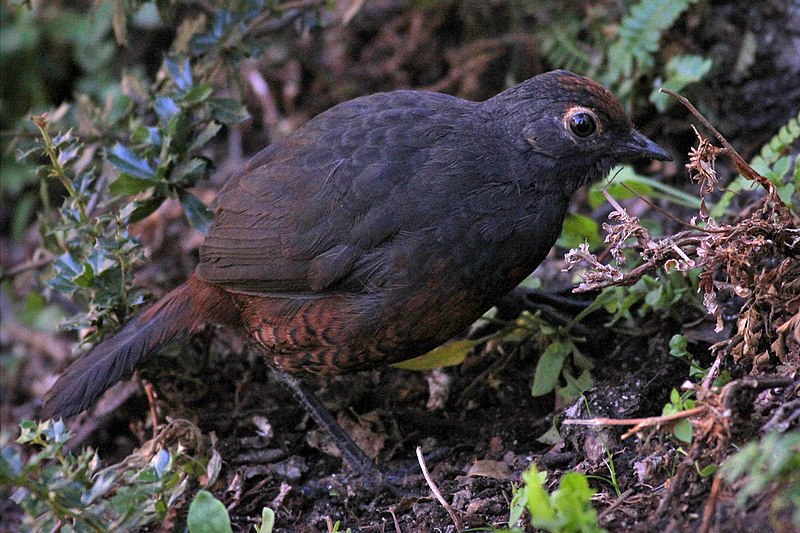
The Black-throated huet-huet bird is a species of bird found in southern/central Chile and western Argentina. This bird is from the family Rhinocryptidae and is known for its beautiful and unique appearance.
With its natural habitat being in temperate forests, the Black-throated huet-huet can be found in the Chiloe National Park near Cucao, Chile.
This species is considered one of the most interesting birds to observe due to their behaviour and distinct vocalizations.
The Black-throated huet-huet has a beautiful song and is known as the “wet-wet” bird in Spanish.
These birds are a fascinating addition to the ecosystem, capturing the attention of many birdwatchers around the world.Scientific classification:
| Kingdom | Animalia |
| Phylum | Chordata |
| Class | Aves |
| Order | Passeriformes |
| Family | Rhinocryptidae |
| Genus | Pteroptochos |
| Species | P. tarnii |
43. Chucao Tapaculo
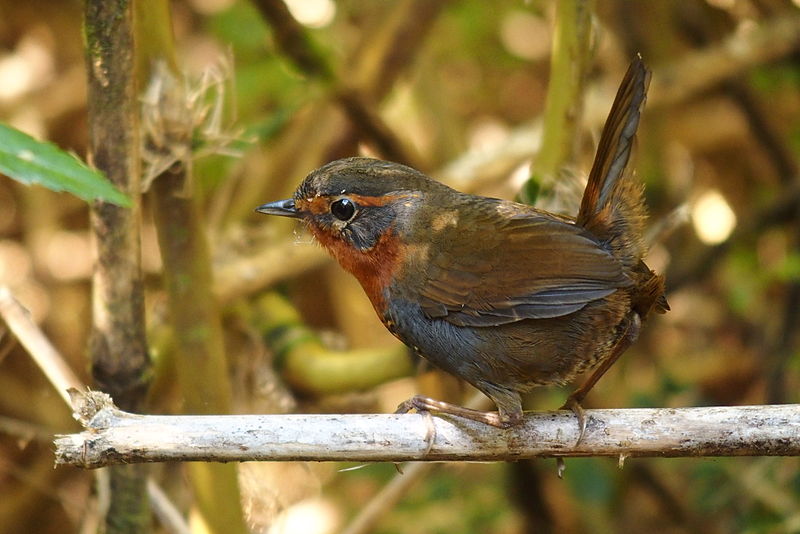
The Chucao tapaculo is a bird species that belongs to the family Rhinocryptidae. It can be found in the central region of Chile as well as in adjacent areas of Argentina.
This bird has also been spotted in Chile’s Magallanes Province. Two subspecies of the Chucao tapaculo exist, with the nominate Scelorchilus rubecula rubecula being primarily found in the central region of Chile, ranging from the Biobío Region to the Aysén Region and its adjacent areas.
It is a small bird known for its distinctive sounds made through its tap-dancing movements. The Chucao tapaculo prefers to live in the undergrowth of moist, temperate forests and is often hard to spot due to its shy nature.
Despite this, the Chucao tapaculo holds significant cultural importance among the Mapuche people, who view this bird as a symbol of power and wisdom.Scientific classification:
| Kingdom | Animalia |
| Phylum | Chordata |
| Class | Aves |
| Order | Passeriformes |
| Family | Rhinocryptidae |
| Genus | Scelorchilus |
| Species | S. rubecula |
44. Green-Backed Firecrown
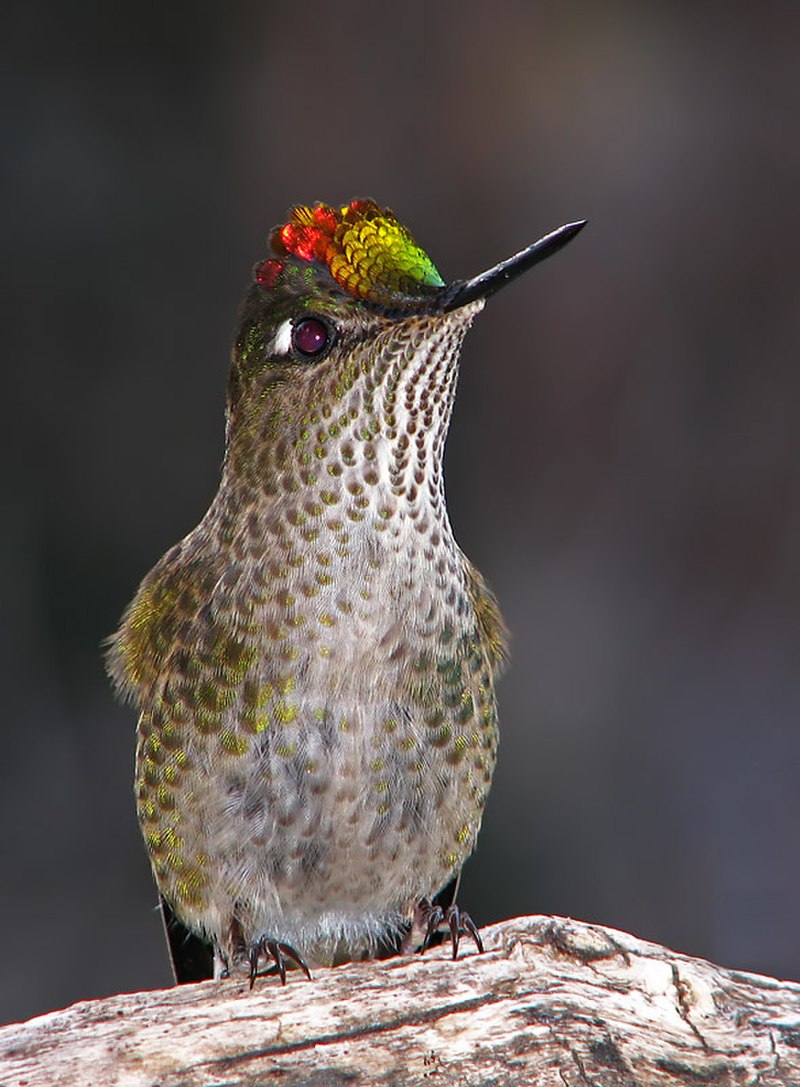
The green-backed firecrown is a unique hummingbird found in Argentina, mainland Chile, and the Juan Fernández Islands. It is the only species in its genus and shares it with only one other species, the Juan Fernandez firecrown.
This bird is commonly known as a “coquette” and belongs to the tribe Lesbiini of the subfamily Lesbiinae.
It has a distinctive green color on its back, giving it its name, and a crown of feathers on its head that often appears fiery in the sunlight.
Despite being small, the green-backed firecrown is known for being quite territorial, especially around food sources.
It is a skilled flier, able to hover in mid-air and rapidly dart from one place to another. It is also a nectar feeder and plays an important role in pollination.Scientific classification:
| Kingdom | Animalia |
| Phylum | Chordata |
| Class | Aves |
| Clade | Strisores |
| Order | Apodiformes |
| Family | Trochilidae |
| Genus | Sephanoides |
| Species | S. sephaniodes |
45. Coscoroba Swan
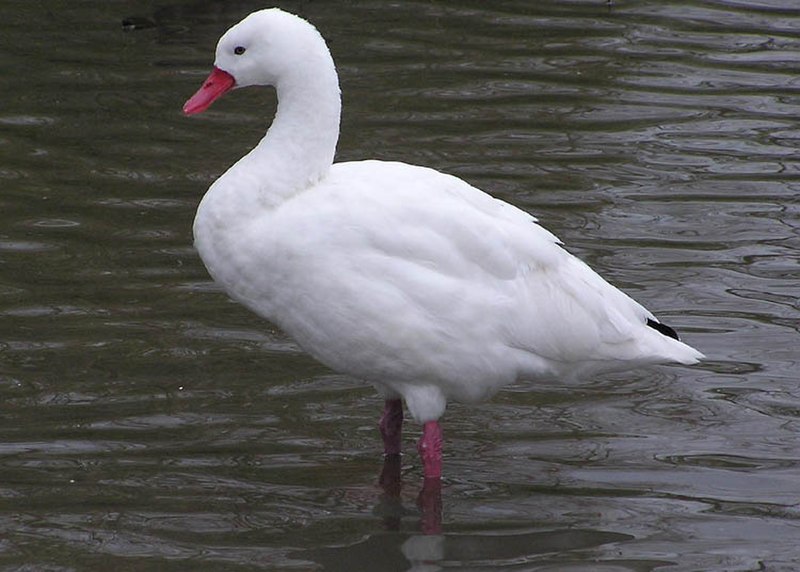
The Coscoroba swan is a beautiful waterfowl species found in different parts of South America and the Falkland Islands. It is a member of the Anatidae family and has a close relationship with the Cape Barren goose according to a genetic study.
The Coscoroba swan is known for its imposing white plumage with black-tipped wings, pinkish-red legs, and a black beak.
It feeds on aquatic plants and invertebrates and is mostly found in freshwater habitats such as lagoons, lakes, and ponds.
The species is considered a least concern by the IUCN Red List, but some populations face habitat loss and hunting pressure.
The Coscoroba swan is a graceful bird that adds beauty to its natural habitats and serves as a valuable part of South American biodiversity.Scientific classification:
| Kingdom | Animalia |
| Phylum | Chordata |
| Class | Aves |
| Order | Anseriformes |
| Family | Anatidae |
| Genus | Coscoroba Reichenbach, 1853 |
| Species | C. coscoroba |
46. Flying Steamer Duck
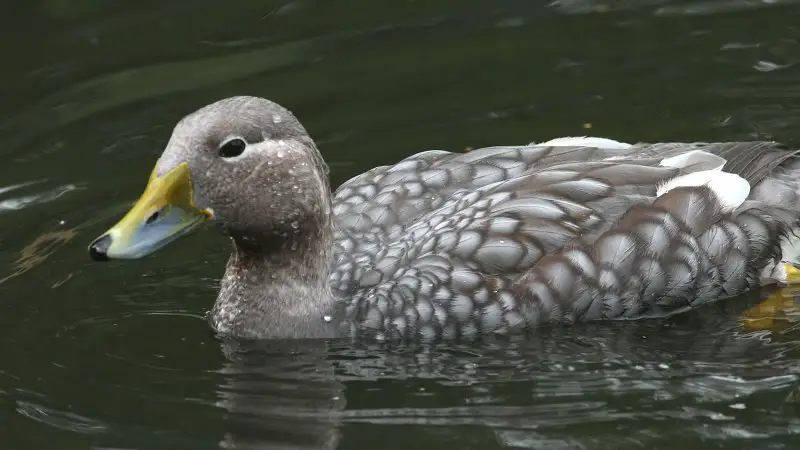
The flying steamer duck, a member of the Anatidae family, is a South American duck also known as the flying steamer-duck.
It is one of four steamer ducks in the Tachyeres genus, along with the Falkland, Fuegian, and Chubut steamer ducks.
These ducks are named for their behavior of propelling themselves through the water like a steamship with their wings.
The flying steamer duck has a distinctive white stripe above its eye and is capable of flight, unlike its flightless relatives.
Their diet consists mainly of crustaceans, mollusks, and small fish. These ducks are found in the coastal regions of southern Argentina, Chile, and the Falkland Islands.
Due to habitat loss and hunting in some areas, the species is considered Near Threatened by the IUCN Red List.Scientific classification:
| Kingdom | Animalia |
| Phylum | Chordata |
| Class | Aves |
| Order | Anseriformes |
| Family | Anatidae |
| Genus | Tachyeres |
| Species | T. patachonicus |
47. Grey-Hooded Sierra Finch
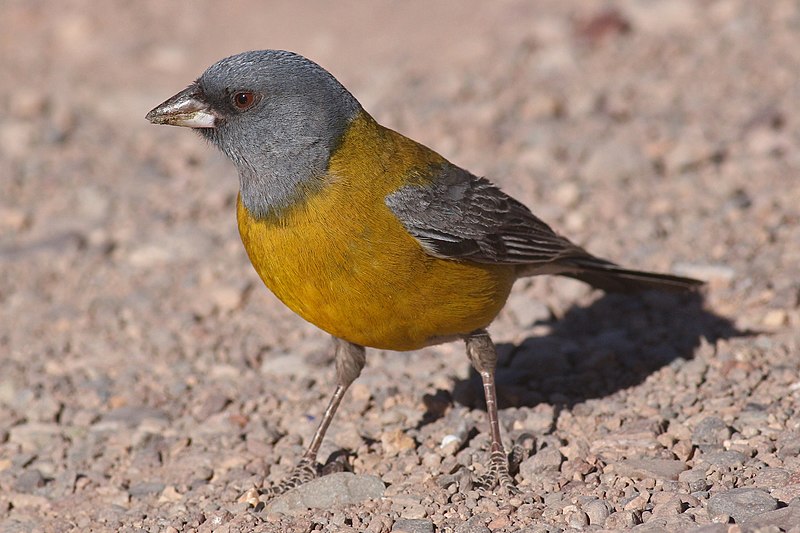
The Grey-hooded sierra finch is a species of bird belonging to the Thraupidae family. This bird is commonly found in the high-altitude shrublands of Argentina and Chile.
The natural habitats of this species are subtropical or tropical dry shrublands. The finch has a grey-colored hood on its head which distinguishes it from other finches. It is known for its beautiful song and is a popular species among bird watchers.
The Grey-hooded sierra finch is a small bird, and the males have more vibrant and colorful plumage than females.
This species is an important part of the ecosystem as it helps pollinate plants and is a food source for many predators.
Despite being relatively common in some regions, the Grey-hooded sierra finch is still considered a species of least concern according to the International Union for Conservation of Nature (IUCN).Scientific classification:
| Kingdom | Animalia |
| Phylum | Chordata |
| Class | Aves |
| Order | Passeriformes |
| Family | Thraupidae |
| Genus | Phrygilus |
| Species | P. gayi |
48. Lesser Horned Owl
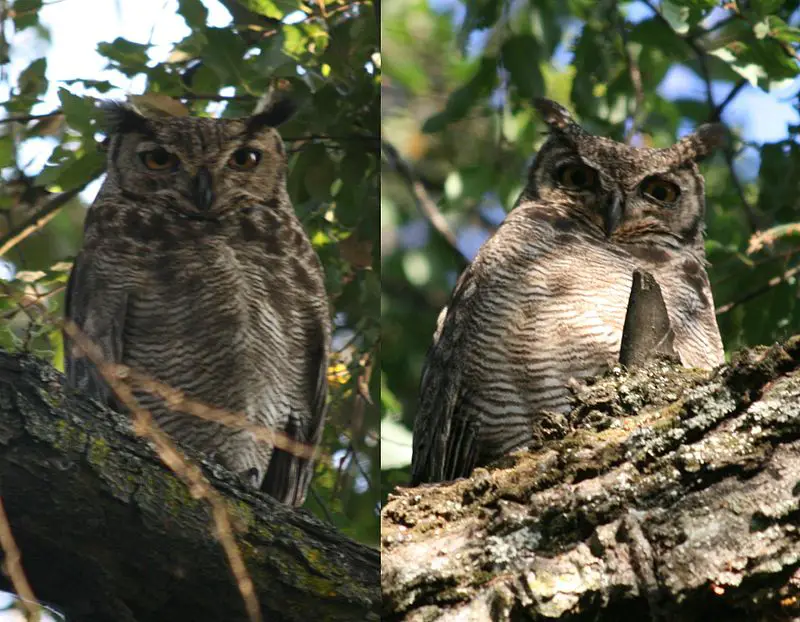
The Lesser horned owl, also known as the Magellanic horned owl, inhabits southern South America and the central Andes.
Previously classified as a subspecies of the great horned owl, it is now considered a separate species due to distinct differences in voice, size, and genetics.
This large owl belongs to the Bubo genus and is well adapted to its environment. Its appearance is characterized by its prominent ear tufts or “horns.”
The Lesser horned owl is a skilled predator, hunting at night and feeding on a variety of prey, including rodents, birds, and small mammals.
Although not much is known about its conservation status, the Lesser horned owl faces threats from habitat loss and human persecution.
Its unique characteristics and ecological importance make it a valuable and fascinating bird species.Scientific classification:
| Kingdom | Animalia |
| Phylum | Chordata |
| Class | Aves |
| Order | Strigiformes |
| Family | Strigidae |
| Genus | Bubo |
| Species | B. magellanicus |
49. Ashy-Headed Goose
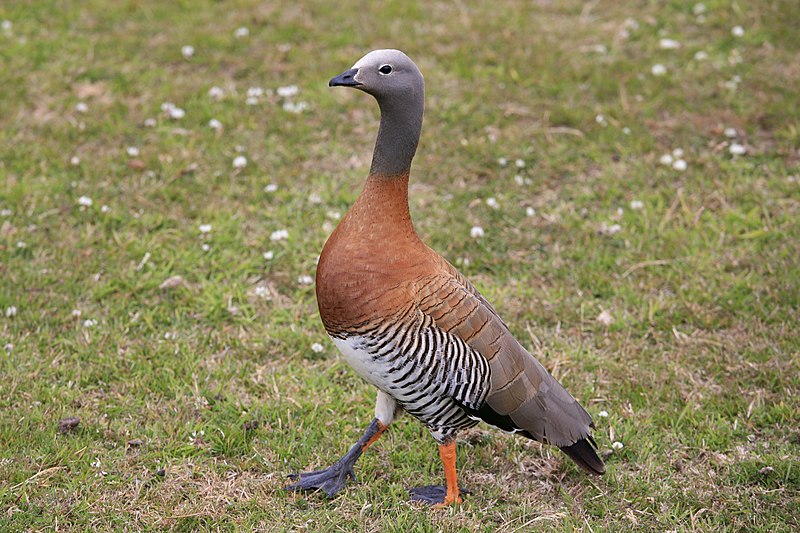
The Ashy-headed goose is a waterfowl species found in Argentina and Chile. It is the only member of its genus.
The birds measure 50-60 cm in length, with males weighing 1.62-2.27 kg and females weighing 1.47-1.49 kg.
Both sexes have the same plumage with ashy-grey heads and necks. These geese inhabit freshwater lakes, ponds, and rivers, feeding on aquatic vegetation and small invertebrates.
During the breeding season, they form monogamous pairs, with females laying 6-10 eggs in a nest constructed from grasses and feathers.
As a migratory species, they move to more southern areas during the winter. Threats to the Ashy-headed goose include hunting and habitat loss from agriculture and urbanization.
Conservation efforts are underway to protect their populations.Scientific classification:
| Kingdom | Animalia |
| Phylum | Chordata |
| Class | Aves |
| Order | Anseriformes |
| Family | Anatidae |
| Genus | Chloephaga |
| Species | C. poliocephala |
50. Austral Canastero
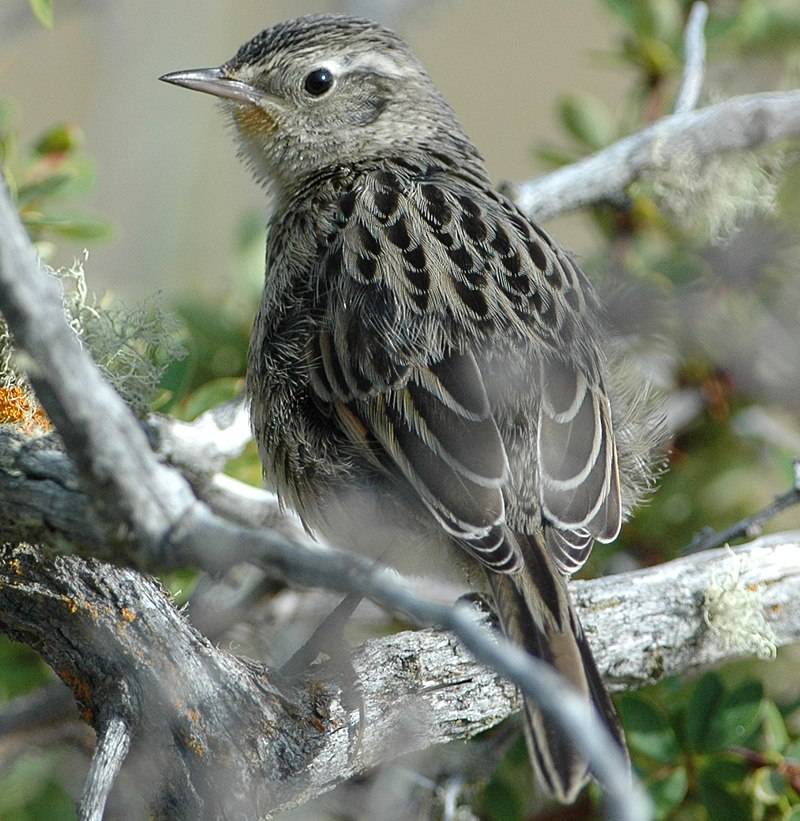
The Austral canastero bird belongs to the family Furnariidae and is found in southern Argentina and Chile. This species is partly migratory and extends its range northwards during the austral winter.
Its natural habitats consist of temperate shrublands and grasslands in non-arid regions of Patagonia. Foraging on the ground for insects, the Austral canastero is a unique and fascinating bird species.Scientific classification:
| Kingdom | Animalia |
| Phylum | Chordata |
| Class | Aves |
| Order | Passeriformes |
| Family | Furnariidae |
| Genus | Asthenes |
| Species | A. anthoides |
51. Chubut Steamer Duck
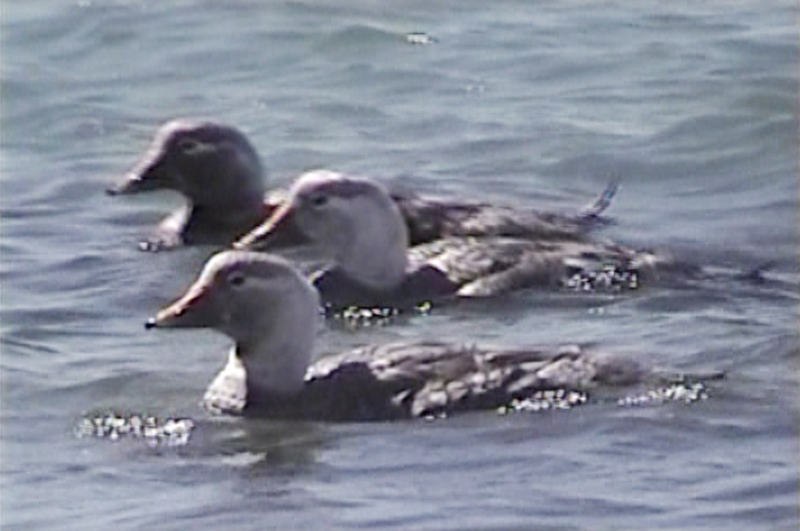
The Chubut steamer duck, also known as the white-headed flightless steamer duck, is a unique bird found in Argentina. Unable to fly, it is classified as a flightless duck and was only recently discovered in 1981.
This species of steamer duck is native to a small area along the coast of Golfo San Jorge in southern Chubut and northern Santa Cruz Provin.
Since this region is little populated, the bird has managed to maintain its distinct characteristics and behavior without much interference from humans.
The Chubut steamer duck has a white head and is one of the latest additions to the steamer duck family.
Despite not being able to fly, they are still able to swim and are often seen in the shallow water along the coast.Scientific classification:
| Kingdom | Animalia |
| Phylum | Chordata |
| Class | Aves |
| Order | Anseriformes |
| Family | Anatidae |
| Genus | Tachyeres |
| Species | T. leucocephalus |